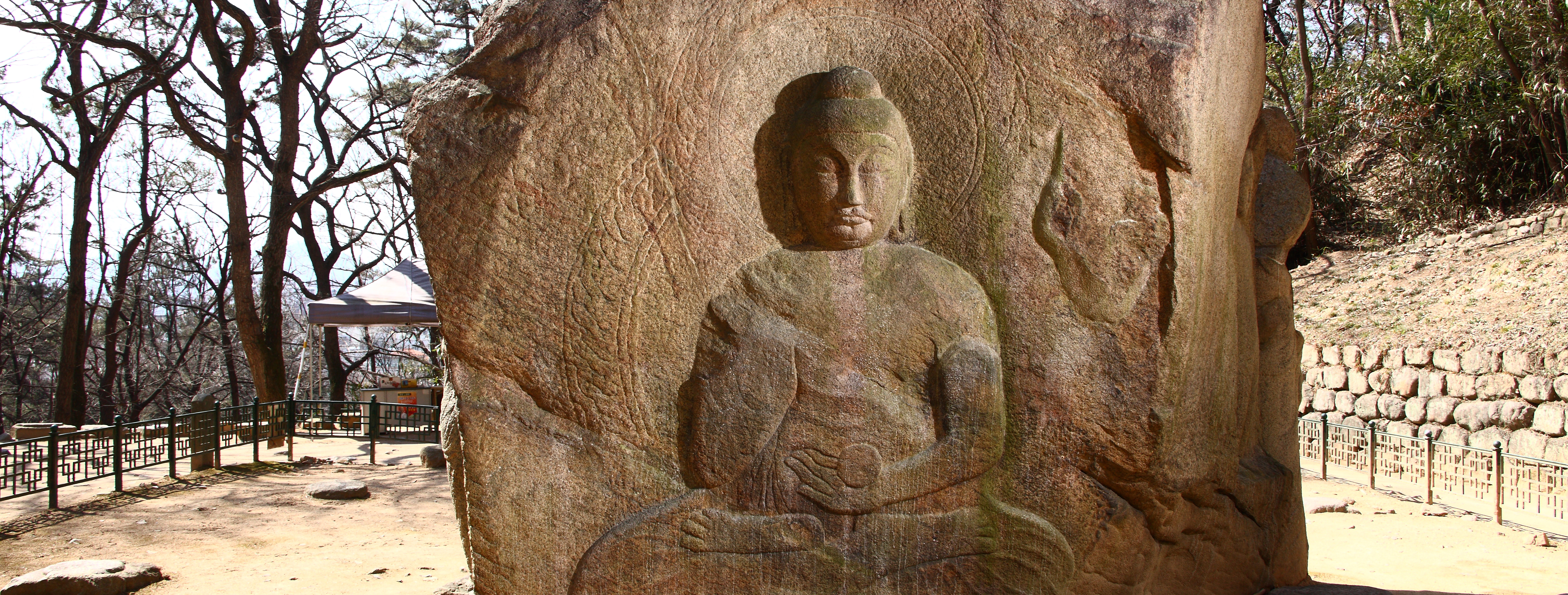- Volume 46 | Permalink
- Print article
- Download PDF 2.8mb
Abstract
Long revered as a sacred realm, Namsan (South Mountain) in Kyŏngju, Korea, is home to both numerous temple ruins and massive boulders on which various Buddhist deities have been carved. One boulder in particular, known as T’apkok monument, is exemplary: its site and visual motif represent the Silla Buddhists’ unique ideal for the Buddha Land, or pulgukt’o. Comparing the visual vocabulary of excavation sites in the Kyŏngju basin, this study interprets the T’apkok sculpture as a rock version of a late seventh-century monastery compound. This new perspective provides a better understanding of how the monument established a stage that anticipated the Buddha’s manifestation on this mountain.
I. Prologue
On Namsan 南山 (South Mountain) in Kyŏngju 慶州, North Kyŏngsang province 慶尚北道, in Korea, the physicality of irregular raw rocks coexists with the religiosity of the manmade images carved upon them.[1] Such a juxtaposition without a recognizable boundary presents a set of questions, principally: how can a natural backdrop frame one’s viewing of a religious monument? One assumes that physical conditions—such as natural lighting, altitude, temperature, scenery, walking paths, and even the presence of flora and fauna—played an important part in the process of viewing, comprehending, or even venerating such a monument. Because it is located on a mountain that has long been revered as a sacred realm, the very connotation of the divine may help or hinder the process in certain ways. Does this line of thought mean that the monument’s images were designed, in their totality, to evoke certain responses from a viewer, who then was expected to perform in a particular manner?
This study presents one possible answer to these questions. The material for this particular quest is a stone monument at T’apkok 塔谷, or Pagoda Valley. The monument is a good example, first of all, due to its location. It is carved on a rock surface on Namsan, a mountain that was highly venerated during the Silla period.[2] Presumably a visitor to this site would have prepared himself or herself to encounter a numinous presence, given the local legends and tales from previous visitors. Second, there is a clear path in situ around the T’apkok monument that helps us reimagine what it would be like to come upon it. It dictates the ascending and descending of one’s footsteps in a relatively clear manner, so that we can envision the carver’s and viewer’s actions. Third, there are neither textual documents nor direct circumstantial evidence regarding the intent of the doctrinal teaching or ritual practice for this site. Such a lack, although perplexing, fascinates researchers, asking that we reconsider the monument’s material presence and spatial configuration in a physical sense rather than resorting to a preconceived or imaginary iconographic program. Lastly, following a historiographical approach, it offers a uniquely stimulating example through which to discuss the history of Buddhist sculpture on the Korean peninsula. Despite the dearth of evidence, this monument has drawn heated discussions regarding every aspect of its features, from its date, visual motifs, style, and connections to a famous monk to the idea of protecting Silla, and even to the earlier practice of esoteric Buddhism in the peninsula.
While extensively and critically benefiting from previous scholarship, this study pursues a rather different direction, delving into questions about how the monument’s physical qualities contribute to the overall experience at the site and what role particular images play in such a process. While this is an alternative reading, unlike the more conventional interpretation, given the current circumstances I believe it is the only way to effectively understand this monument despite minimal evidence. It is a case study that shows the unrestrained imagination of the Silla people in depicting the Buddha’s realm and how it worked at this specific monument and setting.
II. Structure
T’apkok is the third-deepest valley on the northeast part of Namsan. A natural spring with a sanctuary called Ongnyongam 玉龍庵 (Jade Dragon Hermitage) is located along the way to T’apkok.[3] Although of obscure origin, its presence reinforces the notion that historically the site has been a preferred location for an indigenous cult and Buddhist practice alike. Indeed, the entire area has long held religious significance; adjacent to T’apkok are Pulgok 佛谷 (Buddha Valley) to the north and Mirŭkkok 彌勒谷 (Maitreya Valley) to the south (fig. 1). The Pulgok sculpture in particular marks this whole area as a place where the earliest Buddha image was carved on the mountain. The larger region includes the fortress of Namsan to the west and Nangsan 狼山 to the east.
The T’apkok monument, designated Treasure No. 201, is believed to have been constructed during the Unified Silla period (668–935 CE). Although no textual account records a specific date or even a terminus ad quem, our well-grounded knowledge of the stylistic development of Unified Silla sculptures as well as the overall chronology of Namsan monuments suggest an approximate date for the main boulder sculpture: the seventh century.[4] I agree with the late seventh-century date on the basis of plausible associations with monuments such as Pulgok and Mirŭkkok, the carving in Pukchiri 北枝里 in Ponghwa 奉化, Wŏlchi 月池 (Moon Pond), and Sach’ŏnwangsa 四天王寺 (Four Guardian Kings Temple), to which I will return in the following sections.

The T’apkok monument consists of three major parts: (i) a massive boulder with relief images carved on its four surfaces (fig. 2), (ii) a freestanding sculpture directly in front of the southern side of the boulder (fig. 3), and (iii) a freestanding, three-story stone pagoda on the southern slope (fig. 4). Some additional images are scattered on the rocks nearby (figs. 5, 6). These images have an irregular arrangement, following the natural shapes and positions of the available surfaces.
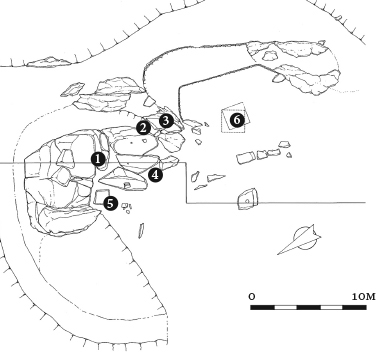
- Buddha triad on the south side
- Seated monk on the southern part of the east side
- Guardian on the southern end of the east side
- Seated monk on a separate rock on the south side
- Standing Buddha
- Pagoda (the dotted line denotes its presumed original location/direction)
Carvings on the main boulder are in bas-relief and do not bear any obvious clue as to whether they are part of a deliberate program, given that the motifs are placed in an irregular manner, and there are only a limited number of iconographic indicators. Their overall arrangement does not suggest any coherent scheme or sequence to the motifs. Included are two pagodas and a Buddha on the north wall (figs. 7, 7A), which contrast with a triad image and a seated monk on the south wall (figs. 8, 8A, 8B). The east wall has a seated Buddha with a bodhisattva and two seated monks (figs. 9, 9A), while the west wall has only one seated Buddha (figs. 10, 10A). Flying heavenly deities are carved on most walls, but their relationship to the central deities is unique (figs. 7A, 9A, 10a).

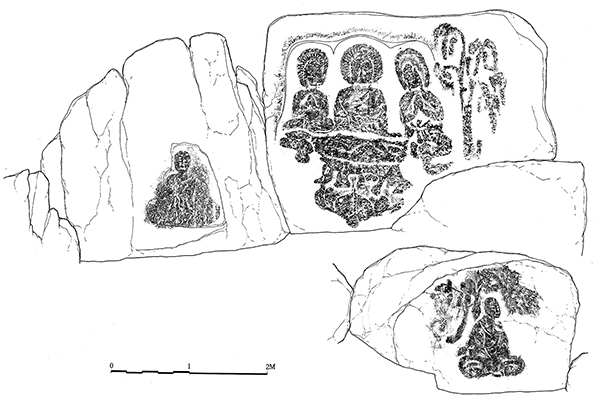
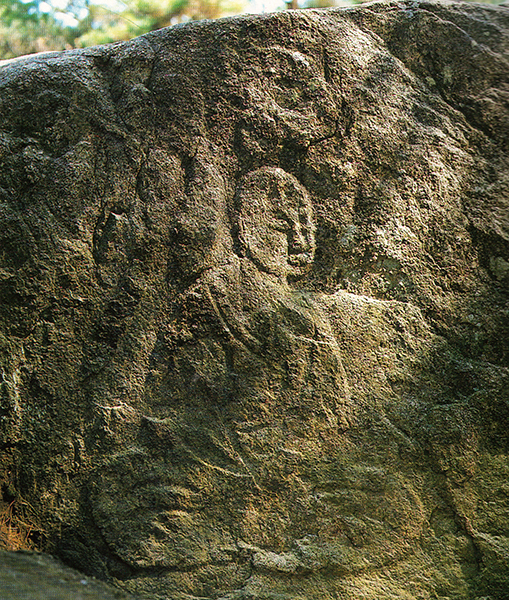
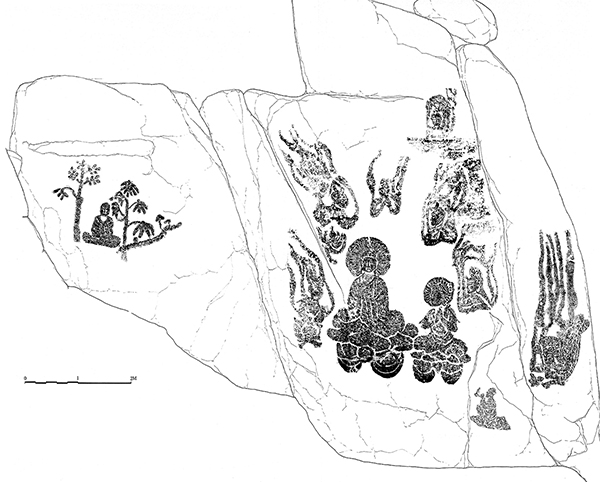
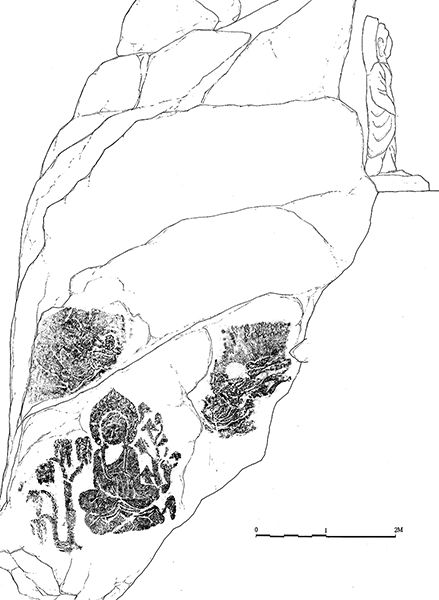
Possible initial interpretations of this sculpture, although never formulated in previous research, include (i) a pictorial illustration of a narrative from an oral/written text,[5] (ii) a diagram signifying a certain doctrine, belief system, or specific world view, (iii) a representation of Four Directional Buddhas (sabangbul 四方佛),[6] and (iv) a collection of random images, either carved at once or accumulated over time. Although each exposition has its own merit, they are all equally baffling and thus hard to confirm, since no proof exists.
My own understanding of this monument is that it is a conglomeration of loosely organized images revolving around the notion of the Buddha Land. I do not present this interpretative frame of the Buddha Land as a novel approach, since scholars of Silla literature, history, religion, and art have consistently applied it to their comprehensive studies of the period.[7] Scholars agree that the ideal of pulgukt’o 佛國土, or the Buddha Land, was formulated and utilized by Silla royalty, aristocracy, and monastic elites. This ideal does not entail a specific cosmological dimension based on a particular Buddhist doctrine; rather it defines the earthly terrain of Silla as a place that had been inhabited by Buddhas over a long period of time and now was ruled by Buddhist rulers. The Silla court presented itself to have had a deep and longstanding kinship with the Buddha. For example, several members of the Silla royal family took their names either from Śākyamuni’s family, as in the case of King Chinp’yŏng 真平王 (reigned 579–632)[8], or from Buddhist texts, as seen in Queen Sŏndŏk 善德女王 (reigned 632–47).[9] In addition, several contemporaneous locales in the Silla territory were fairly specifically identified as monastery sites of past Buddhas.[10] Silla was ultimately promoted as a land with karmic connections to the Buddhist teachings of the past, a special realm that was currently home to and protected by numerous deities, and the future site of the divine epiphany of the Buddha.
It is useful to consider the pulgukt’o ideal as an overarching elucidative rubric in our current endeavor. In this study, I aim to further deploy it to understand this peculiar T’apkok monument, by providing circumstantiated observation of the carved rock itself as well as Namsan in its entirety. At the same time, I propose that the T’apkok carving could, in fact, present itself not only as a materialization of a pulgukt’o ideal, but also as a rock version, albeit in miniature, of a contemporaneous monastery compound.[11]
In other words, the site claims its authority not from its iconographic “program” but instead from the pulgukt’o ideal that unfolds at the site by virtue of its legend, scenery, path, boulder, and viewing sequence of the imagery. The viewer perceives and senses the whole site and boulder just as if he or she were entering a monastery complex and venerates the carved images while circumambulating the boulder. While the viewer must walk to experience the site fully, it is also true that the steps of experiences are prescribed. Here, the T’apkok monument interacts with the viewer not necessarily as an object of exploration but as an agency through which one may come to understand the greater implications of the site as a Buddha Land.
III. Issues
Discussions on the T’apkok monument are exceedingly complicated, but overall they revolve around two main themes. One is its association with an early form of esoteric Buddhism on Silla soil; the other is the relevance of reading the monument as “Four Directional Buddhas.”
1. Myŏngnang 明朗 Connection?
The entire case for defining the T’apkok monument as a material corollary of an embryonic phase of esoteric Buddhism stems from a Japanese scholar’s site report during the Japanese colonial period (1910–45). The second volume of a series titled Catalogue of Treasures and Ancient Sites of Chosŏn (Chōsen hōmotsu koseki zuroku 朝鮮寶物古蹟圖錄), The Buddhist Monuments of Namsan in Kyŏngju (Keishū Nanzan no busseki 慶州南山の佛蹟), was published in 1940; it represents the earliest modern research on the subject. Included in the catalogue was Oba Tsunekichi’s 小場恒吉 report, which stated:
Considering that a roof tile fragment bearing an inscription of “Sininsa 神印寺” was discovered in the [T’apkok] area before, we can infer that a magnificent Buddha Hall had once been constructed here.[12]
Given that a masterpiece like this could be achieved in the past using a gigantic rock cliff, we can certainly presume that the adjoining monastery with halls and pagodas also looked spectacular. Accordingly, it is worthwhile to consider Mr. Ōsaka’s mention that it is identified as Sininsa based on the inscription of a roof tile excavated from this temple site.[13]
Several scholars have accepted the value of this report in explaining the T’apkok site’s doctrinal orientation.[14] The temple name Sininsa encouraged the assumption that the site was related to the Sininjong 神印宗 school, which with the Ch’ongjijong 摠持宗 constituted two major streams of esoteric Buddhism on the Korean peninsula.[15] Similarly, it was argued that Myŏngnang, the presumptive founder of the Sininjong, was somehow involved in this site.
Myŏngnang’s active role in Silla’s unification war was clearly delineated in the Samguk yusa 三國遺事 (Memorabilia of the Three Kingdoms).[16] It provides two accounts about Myŏngnang’s family background, study, and ritual practice: one in the section titled “King Munmu whose posthumous title was Pŏmmin (Munhowang Pŏmmin 文虎王法敏)” and the other in “Myŏngnang Divine Seals (Myŏngnang Sinin 明朗 神印).”[17] The latter records that Myŏngnang was born to Sagan Chaeryang 沙干才良[18] and Lady Namgan 南澗夫人 (Pŏpsŭngnang 法乘娘). His mother, Lady Namgan, was born to Sop’an Murim 蘇判 茂林[19] and was the sister of the famous vinaya master and state preceptor Chajang 慈藏 (fl. 636–50), thus making the latter Myŏngnang’s maternal uncle.[20] Myŏngnang’s two brothers, Kukkyo taedŏk 國教大德 and Ŭian taedŏk 義安大德, held prestigious status; the honorific title of taedŏk 大德, or Monk of Great Virtue (Sanskrit: bhadanta), was bestowed upon monks who had performed noble and virtuous actions.[21] As the noble scion of such an eminent family, Myŏngnang had the privilege of traveling to Tang China in 632; after three years of study, he returned to Silla.[22]
When the Tang navy invaded Silla in 670, King Munmu 文武王 (reigned 661–81) consulted Myŏngnang, who was believed to have already mastered the “Munduru 文頭婁, 文豆婁 Secret Method” in the Dragon Palace.[23] Munduru is a transliteration of mudra, which in this case implies esoteric practice and is often translated as Divine Seals (Sinin 神印).[24]
Myŏngnang suggested to the king that they should build Sach’ŏnwangsa in Sinyurim 神遊林 (Divine Wandering Forest), south of Nangsan.[25] Due to time constraints associated with the national crisis, they were forced to build a makeshift version of Sach’ŏnwangsa using multicolored silk and then install temporary images of the Five Directional Deities (obangsin 五方神), made of grass and straw, which was followed by the ritual of the “Munduru Secret Method.” [26] Myŏngnang and twelve eminent Yoga (Korean: Yuga 瑜伽) monks led the Munduru ceremony, after which the entire Tang navy was destroyed before the first battle.[27] To commemorate this miraculous victory, the Unified Silla court actually constructed Sach’ŏnwangsa in 679, the nineteenth year of King Munmu’s reign, on this de facto sanctified site, chosen to represent the unification war; its ruins remain today at the foot of Nangsan.[28]
In sum, if we accept as credible the report of a roof tile inscribed “Sininsa” and its possible relationship to both Sininjong and Myŏngnang, the T’apkok site seems similar to Sach’ŏnwangsa. Both can be associated with “state-protection Buddhism” as well as with the esoteric practice of Munduru. However, this interpretation has been questioned because the actual tile described in the Japanese scholar’s report is missing. No photo of the tile exists; no one has seen it since, and the author himself probably never saw it in person. Some scholars, therefore, do not accept the site’s association with Sininsa and doubt Myŏngnang’s involvement in T’apkok.[29]
Considering the lack of physical proof, dismissing Oba’s report may seem justifiable. In fact, most recent scholarship does just this. I believe, however, the comparison to state-sponsored Sach’ŏnwangsa is so compelling that it cannot simply be abandoned. It is helpful to remember that T’apkok is located at a visible distance from Sach’ŏnwangsa. To be more specific, the T’apkok area offers an exceptional view of the north toward Nangsan, and this view includes Sach’ŏnwangsa at a distance of 700 meters (figs. 1, 11). Its physical proximity suggests that T’apkok carvings and adjacent monuments were somehow connected in a shared socioreligious atmosphere, in which Silla was viewed as a consecrated Buddhist realm, even if it did not directly share in the collective yearning for state protection from the Buddha.
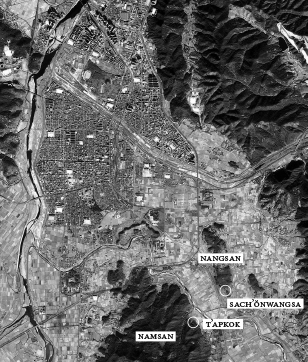
Sach’ŏnwangsa was not only a sacred site that represented Silla’s unification war but also a magnificent construction in terms of visual spectacle. Unfortunately, only parts of the foundation remain; yet it still covers an area 105 meters long on the north-south axis and 73 meters long on the east-west axis. Based on site examinations, scholars have shown that from the south gate, one had to climb a manmade hill, where the temple cloister had been built. Because it was easily visible, the temple architecture must have been imposingly grand.[30]
Sach’ŏnwangsa also had a government office called the sŏngjŏn 成典, which was charged with managing and refurbishing the monastery.[31] Such offices existed in a few other temples, including Hwangnyongsa.[32] Temples with such offices did not belong to any individual member of the royal family or aristocrat, but they were recognized as state temples, kukch’al 國剎, that belonged to the government and by extension to the entire kingdom. Among the temples with Sŏngjŏn offices, Sach’ŏnwangsa had the largest and most complicated organization. Such extensive state involvement indicates that Sach’ŏnwangsa was the focus of the court and played a central role in the state activities.
Typically, in an area dominated by a major monument, any monument built in the vicinity will be influenced by the existing one. In constructing another site for worship close to the court-sponsored building, although with a different form of rock carving, the patrons at T’apkok presumably had a particular purpose in mind. The imposing presence of double pagodas on the north wall and the massive statue of a freestanding Buddha on the south ground at T’apkok—even though the latter was likely added later—as well as the flowing lines of each skillfully carved motif collectively suggest some artisanship (admittedly not the most sophisticated or sumptuous) and considerable financial support. While Sach’ŏnwangsa was intended as a state temple, a monument such as T’apkok likely received patronage from an individual member of a prominent family.
Several historical connections suggest that Myŏngnang had ties to Namsan both through family and his esoteric practice. First, in terms of family ties, Namsan was recognized as the place where Lord Murim 虎林公,[33] father of Chajang and grandfather of Myŏngnang, gathered with high officials to decide important state matters.[34] Second, Namgansa 南澗寺 at Changch’anggok 長倉谷, at the northwest foot of Namsan, was associated with and took its name from Lady Namgan, Myŏngnang’s mother.[35] Its surrounding areas are thought to have been the manor of the family of Chajang and Myŏngnang.[36] Today the temple site is reduced to its flagpole bases and other scattered fragments; it sits just below the foot of Namsan and is connected to T’apkok by a walkable path (fig. 1).[37] Lastly, Kŭmgwangsa 金光寺 at Changch’anggok was originally Myŏngnang’s personal residence.[38] According to the Samguk yusa, he came back with one thousand strings of gold, given to him by the Dragon King as payment for his teaching, and mysteriously went underground beneath his own house, only to soar from its well.[39] He donated his house so it could be converted into a monastery and embellished its pagoda and Buddha images with the gold that he had received.[40] This site is also located near Namgansa.[41]
Despite this circumstantial evidence, Myŏngnang’s connection to the T’apkok monument has been elusive and thus hard to support. However, ignoring those fragmentary indicators might be a mistake. T’apkok is located between Sach’ŏnwangsa and Myŏngnang’s family base in the Changch’anggok area. Between these two spots, a massive granite boulder sits atop a freely flowing mountain spring, and it presumably presented a prime location to carve divine images and create a proper shrine.
Returning to the story of the Sininsa roof tile, the excavation of tiles inscribed or stamped with temple names from nearby sites, such as Sach’ŏnwangsa[42] and Ch’angnimsa 昌林寺,[43] on which the style and method of seventh-century craftsmanship has been preserved suggests that it is also quite possible to uncover Unified Silla tiles with inscribed names at adjacent sites on Namsan. Roof tile-ends with patterns (yumun wadang 有文瓦當) also have been unearthed near the north cliff of the T’apkok boulder.[44]
Further, given the character of Oba’s report, perhaps his observation should be seen as credible. His note about the Sininsa roof tile was included in a catalogue of more than a hundred black-and-white photos with meticulous drawings and measurements executed by the Japanese colonial government.[45] The catalogue was not a light journalistic write-up but rather a volume of an official series based on thorough site research.
Interestingly, Oba cited Ōsaka’s finding of the roof tile but did not further explain Ōsaka’s role. Neither did Korean scholars studying the T’apkok monument, and they seemed to dismiss his observation.[46] The catalogue’s foreword, however, lists people who helped with the site research, including Ōsaka Kintarō 大坂金太郎,[47] a well-known researcher specializing in Silla monuments. Ōsaka wrote several articles and books on the temple sites, steles, and artifacts.[48] Along with fellow members of the Society for Preserving Kyŏngju’s Ancient Sites (Keishū koseki hozonkai 慶州古蹟保存會), he published the Site Report of Ancient Sites, Monuments, and Objects of Kyŏngju (Keishū koseki oyobi ibutsu chōsho 慶州古蹟及遺物調書) in 1931. In that report, Ōsaka matched temple names known from texts to actual ruins, providing a foundation for later research.[49] He was also head of the Kyŏngju branch (Keishū bunkan kanchō 慶州分館館長) of the Japanese Colonial Government Museum (Chōsen Sōtokufu hakubutsukan 朝鮮総督府博物館). His best-known achievement, however, was a discovery on the hill near the Sŏkchangsa 錫丈寺 temple site in 1935: the famous “Stone Tablet with the Inscription of an Oath dated to the Imsin Year (Imsin sŏgi sŏk 壬申誓記石)” from Old Silla, possibly dated to 552 or 612.[50]
More remarkable in the current discussion, however, is that Ōsaka recalled that this stroke of luck occurred on a day when he had been searching for something completely different—tiles inscribed with patterns, temple names, or written characters associated with the Silla’s famed sculptor-monk Yangji.[51] Ōsaka knew that records show Yangji resided in Sŏkchangsa, so he went to that area with the hope of finding some remnant inscriptions at the temple site. While his ultimate contribution on this day was the stone tablet, it is important that he was searching, in fact, for those temple tiles. In short, Ōsaka knew Silla epigraphy and was fascinated by it, as evidenced by his regular excursions to search for new materials. His familiarity with the artifacts in Kyŏngju and expertise in Silla inscriptions suggests that his discovery of the Sininsa roof tile should not be ignored or brushed aside.
Nevertheless, no matter how tempting it might be to assume the reliability of the record regarding such a chance find, it is far from proven. We are, for now, left with fragmentary evidence from various sources—historical texts, site reports, and other physical remnants—that appear to help us comprehend the T’apkok monument, but they remain insufficient. Although Myŏngnang’s connection and Sach’ŏnwangsa’s echo at the monument is hardly deniable, the T’apkok monument is not yet interpretable under the umbrella of esoteric Buddhism in Silla. In the end, the “mysterious” roof tile inscribed with “Sinin,” if it could be located, might be a critical piece of the puzzle. Perhaps a more complete picture of the role of T’apkok in the history of Silla Buddhism and its visual culture will become clearer after the systematic excavation of the T’apkok temple site itself.
2. The Four Directional Buddhas
The literature often refers to the carved deities as the Four Directional Buddhas at T’apkok (T’apkok sabangbul 塔谷四方佛).”[52] Because the monument has various deities carved on each of its four sides, this approach is understandable. Some researchers naturally have focused on identifying the images that constitute this set of four Buddhas.[53] Most have interpreted it as including representations of Akṣobhya (Achu 阿閦), Ratnaketu (Baoxiang 寶相), Amitāyus (Wuliangshou 無量壽), and Madhura-svara-nirghoṣa (Weimiaosheng 微妙聲).[54]
The Four Directional Buddhas were said to have first appeared on the Korean peninsula at the end of the Three Kingdoms and during the early Unified Silla period.[55] The first textual account concerns the four-sided Buddhas at Taesŭngsa 大乘寺 on Sabulsan 四佛山 in North Kyŏngsang province, which, according to the Samguk yusa, were made in either 587 or 624.[56] According to legend, a square boulder, its sides carved with four Buddha images and wrapped in red silk, fell from the sky on top of the mountain.[57] Its mysterious appearance suggested a foreign origin, while the copious red silk emphasized its precious and miraculous nature. The boulder is now so badly eroded that a complete reading of its iconography is impossible, but a seated Buddha is depicted on each of two sides, and a standing Buddha is on each of the other two sides.[58]
Many scholars have regarded the sculpture at the Kulbulsa site 掘佛寺址 as a prime example of this iconography, but there, each side has its own distinct theme and scale, without any apparent unifying principle (figs. 12, 12A).[59] Kim Rina has reviewed possible sources for this monument and suggests that it is a collection of popular images from the time rather than a coherent theme and composition based on a single visual source or series of texts.[60]
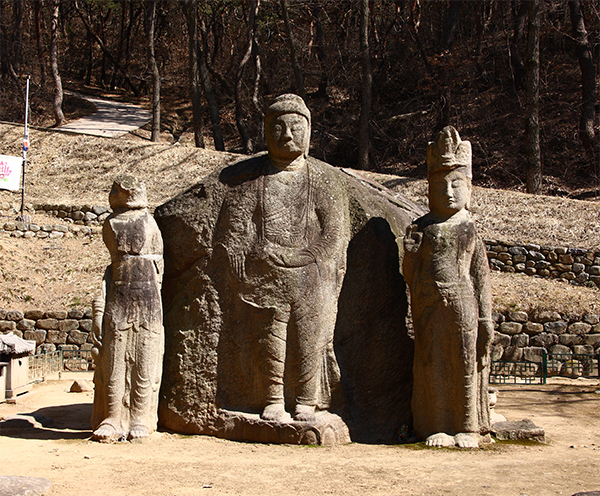
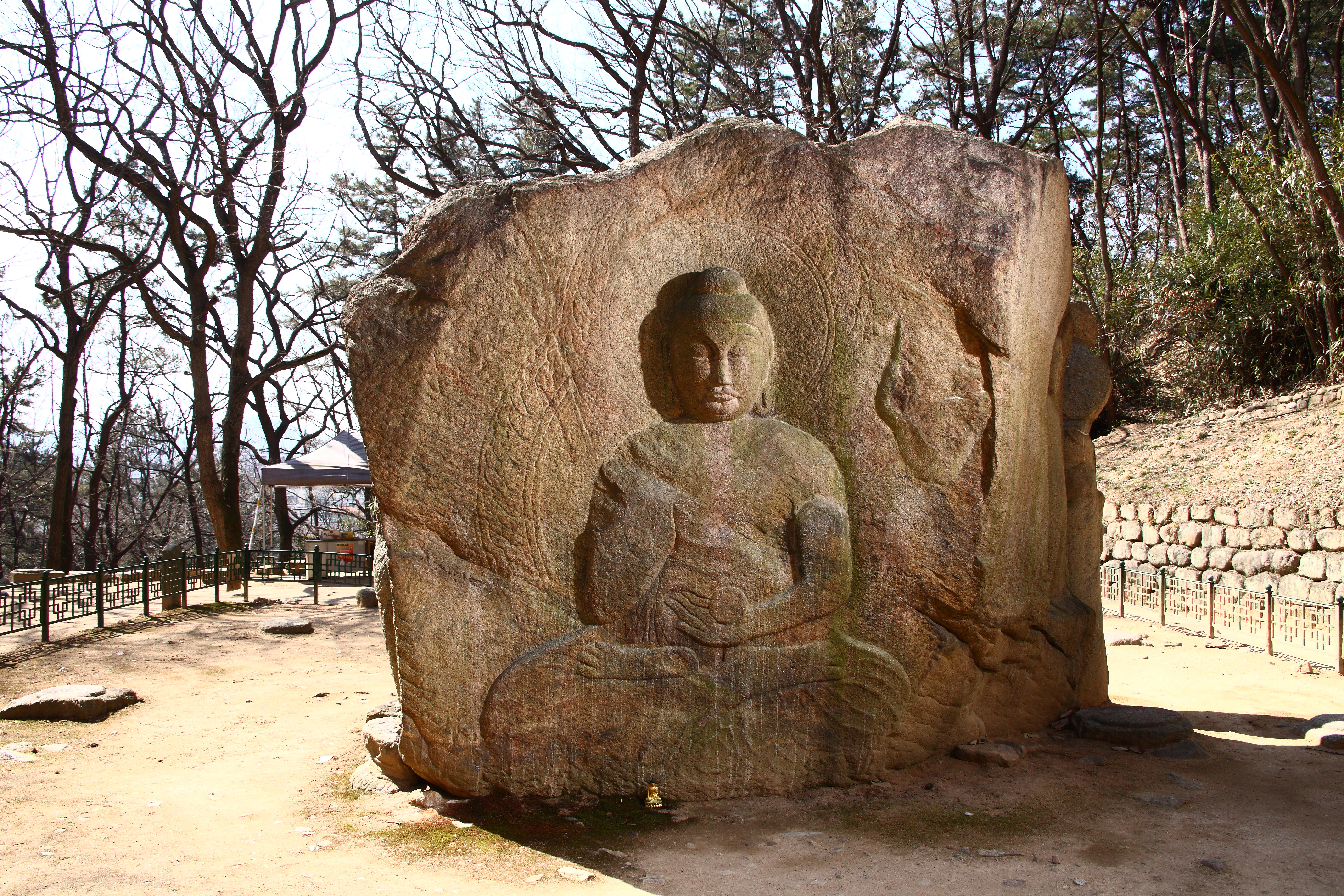
A more remarkable point about the Kulbulsa carving is the legend in the Samguk yusa, which records that it had been excavated. On his way to Paengnyulsa 栢栗寺, King Kyŏngdŏk (reigned 742–65) heard mysterious sounds beneath the ground and ordered his men to dig. When they did, they found a boulder carved on four sides.[61] This legend may hold the key to understanding this image, offering a better fit than the Four Directional Buddhas. In a sense, the monument was alive, producing sounds that appeared to be coming from the earth, and was said to have been found as a finished piece. Just like the Taesŭngsa boulder that descended from above, this Kulbulsa monument has mysterious origins, but here, they are indigenous to Silla, as it was believed to have been underground long before its discovery.
The indigenous nature of this boulder is pivotal to recognizing the Unified Silla territory as a consecrated Buddha Land, presided over by Buddhas and protected by their sacred power. It is believed that Buddhas are inherent to Silla just as the finished piece of Buddhist carving is inherent to its soil. Such an idea is applicable to the T’apkok carving as well as Kulbulsa and presumably is embedded in all Namsan monuments. The T’apkok carving is believed to have been created before the Four Directional Buddhas became an established motif on the peninsula. While sculptures at Taesŭngsa and Kulbulsa required some shaping and preparing of the boulder and its surfaces, T’apkok preserves the natural shape of rock, indicating that materiality and “site-ness” were goals here. Rather than carving one representative deity on each side, the sculptor decided to embellish the available space completely, presumably to depict the splendid realm of Buddha(s) to maximum effect.
Despite its profuse images, the T’apkok monument is peculiar in that its deities lack specific gestures; all hands are covered by robes, the hem of each sticking out in front. Possibly this serves to extend the meditation mudra, but that is not a common mudra for primary Buddha images. Such a mudra often is seen in meditating monastic figures or serial Buddhas in steles and murals in China and Central Asia.[62]
This specific mudra, both hands covered by a garment drape, can be found in some older Korean sculptures. Bronze plaques from Kimje 金堤, North Chŏlla province, dated to seventh-century Paekche, show a main Buddha (fig. 14) as well as rows of small, seated Buddhas with that mudra.[63] Other works from early Unified Silla bear miniature Buddhas with the same mudra in multiple, as seen in the Yŏn’gi 燕岐School steles (figs. 15, 16), and the cliff carving at Pukchiri in Ponghwa (fig. 17). The relief carving at Porisa 菩提寺, close to T’apkok, is perhaps the only instance known to date in which a single main Buddha makes such a gesture (fig. 18).
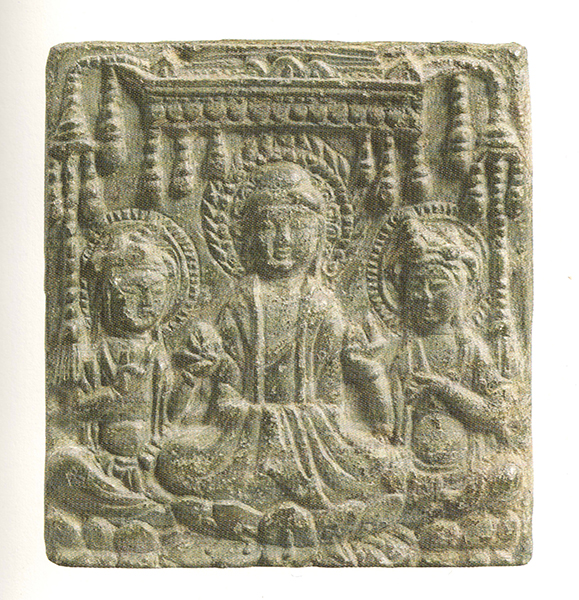
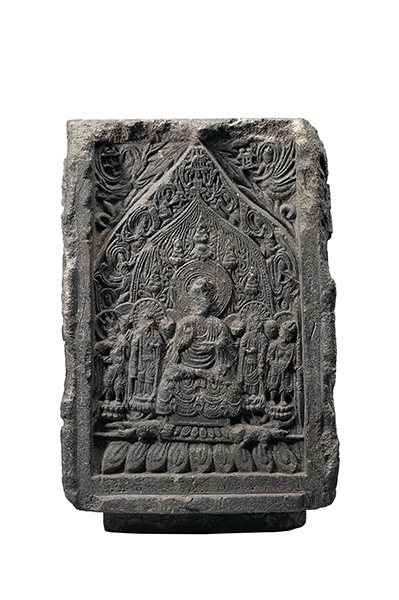
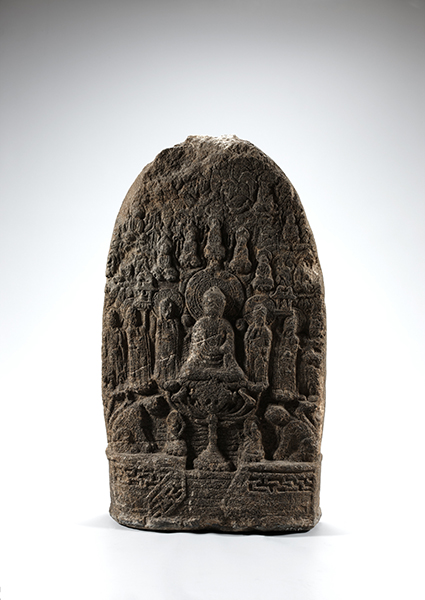
A mudra is often critical to establishing the identity of a depicted figure. Although at times a certain mudra may lead a viewer to conflate identities between two different Buddhas, assigning a distinct mudra for each image in a single sculpture essentially helps to differentiate one deity from another. The reading of the T’apkok carving as Four Directional Buddhas, therefore, becomes most puzzling since they all share the same mudra. Other Unified Silla works, such as the one from Ch’angnimsa pagoda on Namsan, show a discernible mudra for each Buddha (fig. 19). The four seated Buddhas on the top sides of the pagoda show four different mudras: the dhyāna mudra, bhūmisparśa mudra, hands holding a round object, and hands covered by a robe. Although the Buddhas’ identities are unclear, the artist clearly sought to distinguish one Buddha from another.
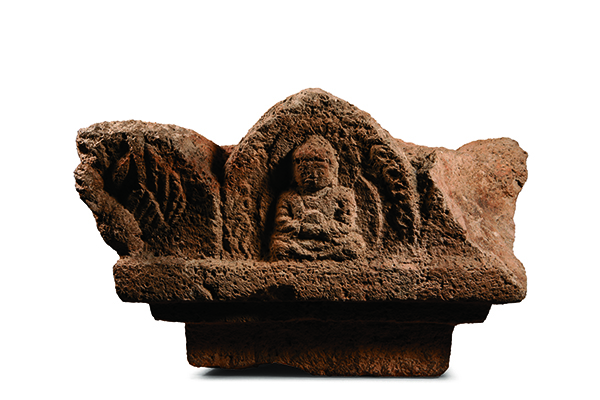
At T’apkok, on the other hand, not only do the Buddhas share the same mudra, none of them can be singled out as representing any of the four directions. This suggests that the T’apkok carving is not a clear example of the Four Directional Buddhas or any associated iconographic arrangement.
IV. Proposal
1. The Buddha Land Ideal
According to the Samguk yusa, Queen Sŏndŏk foresaw the date of her death and left a will indicating she should be buried in Trāyastriṃśa (Torich’ŏn 忉利天), which she identified as the south slope of Nangsan. She passed away in 647 and was duly buried where she’d requested. More than thirty years later, King Munmu constructed Sach’ŏnwangsa on the same mountain.[64] Since several Buddhist texts specify that Trāyastriṃśa is located above Catur-maharāja-kāyikas, or the Four Heavens of the Four Heavenly Kings (Sach’ŏnwangch’ŏn 四天王天), the construction of Sach’ŏnwangsa might signal the locale of Sach’ŏnwangch’ŏn and thus fulfill the queen’s aspiration regarding her burial in the Trāyastriṃśa.[65]
Queen Sŏndŏk’s burial wishes testify to the Silla people’s idea of their territory as a Buddha Land; the Trāyastriṃśa was believed to be on top of Mount Sumeru, the Buddhist cosmic mountain, conceptually equivalent to Nangsan for Silla believers. However, it is unclear whether Namsan in its entirety was believed to be a Buddhist space like Trāyastriṃśa, Catur-maharāja-kāyikas, or Mount Sumeru. The compilers of the Samguk yusa and epigraphic texts were silent on this matter. Perhaps observations about Namsan’s location and rocky surface offer a better frame for understanding the contemporaneous cultural landscape. Compared to all other symbolically significant mountains, only Namsan has monuments dating from the Unified Silla period in every peak and valley; to date, 147 monastery sites, 107 sculptures, and 96 pagodas have been identified.[66]
The Silla people believed in the potency of the sacred mountains. This is evidenced in their systemization of a set of Three Major Mountains 三山, where the protective gods of the realm were thought to reside; one of them was Nangsan.[67] In addition, Five Sacred Peaks 五嶽 were used for worship—a use that had precedent in China, where the classification of Five Sacred Peaks and Four Famous Mountains is thought to demonstrate Buddhism’s Sinification.[68] Scholars agree that the Five Sacred Peaks in the Korean peninsula, in particular, were formulated to incorporate territories newly acquired during the time of Silla’s unification war.[69] They include T’ohamsan 吐含山 to the east, T’aebaeksan 太伯山 to the north, Chirisan 地理山 to the south, Kyeryongsan 雞龍山 to the west, and P’algongsan 八公山 (Puak 父岳) at the center. These areas symbolized the four regions plus the center, which also functioned as important posts in the state’s military defense.[70]
In addition, the Silla people formulated the Four Numinous Sites 四靈地, that is, Ch’ŏngsongsan 靑松山 to the east, Ojisan 亐知山 to the south, P’ijŏn 皮田 to the west, and Kŭmgangsan 金剛山 to the north.[71] Ojisan 亐知山 designates the Ojiam 亐知巖 on Namsan, thus working as a synecdoche for the latter.[72] Among these four sites, Namsan in particular occupies a special position, because it was here that a major fortress and the first palace cloister in Old Silla were constructed.[73] Namsan was significant for state administration at the time of Silla’s unification too: after his accession to the throne, King Munmu ordered the grain storage and armory (長倉 Changch’ang) to be built there.[74] A number of sites containing remnants of charred grain were excavated from the area, inside New Fortress 南山新城 on Namsan, verifying this account.[75]
Apart from this practical and strategic use, the mountain held symbolic value in Silla. According to the Samguk yusa, the Four Numinous Sites were places where high-ranking officials gathered to discuss important state matters during Queen Chindŏk’s 真德女王reign (647–54).[76] The sites were believed to be auspicious, as shown in the passage “What the high officials planned at a gathering there [i.e., the Four Numinous Sites] definitely came true.” [77] In short, these locations led to successful outcomes. Namsan, in particular, was the only one singled out by an additional detail; it was the site where Lord Alch’ŏn 閼川公, Lord Murim 虎林公, Lord Yusin 庾信公, and other high-ranking officials gathered to discuss state decisions.[78]
Yi Kiyŏng insightfully points out that the Four Numinous Sites share one quality—that is, a large proportion of rocky hills and peaks—and thus they represent the intermingling of indigenous rock cult and Buddhist preferences.[79] The rock cult was embedded in various facets of Silla culture, as captured by the legend of the rock where Buddha Kāśyapa (Kasŏppul 迦葉佛), of the past, is believed to have sat. The Samguk yusa records Kyŏngju as having seven monasteries from the time of the past Buddhas, including Sinyurim on Nangsan, in addition to Dragon Palace South and Dragon Palace North.[80] Dragon Palace South was believed to be where the original stone, the meditation/teaching seat of Buddha Kāśyapa, was located, and therefore the royal temple Hwangnyongsa was constructed there.[81]
The belief in the existence of the meditation/teaching seat of the Buddha Kāśyapa and the seven monasteries of the past Buddhas is a precursor to the fully developed concept of the pulgukt’o in Silla.[82] According to Kim Yŏngmi, the causality of past Buddhas’ achievements, merits, and powers was emphasized before unification, but afterward, the perception changed and Silla territory was seen as a Buddha Land.[83]
The development of the pulgukt’o trope and the subsequent emphasis on its association with mountains is the key contribution of Chajang, the most influential monastic elite in Silla. He was active during Queen Sŏndŏk’s reign.[84] He went to Tang China in 636,[85] returning in 643 with sutras, monastic robes, and silk bestowed upon him by the Tang emperor. After his return, he resided at several major temples in Kyŏngju and was appointed the first grand state supervisor (taegukt’ong 大國統).
The rhetoric employed in describing his experience is remarkable in that it diagnoses a problem that Silla was facing in claiming the authenticity of Buddhism and then provides a solution. It is said that Chajang “lamented having been born in a remote place [distant from the Buddha’s homeland], and sincerely wished to be educated in the West.”[86] In China, he visited Qingliangshan 清涼山 (Mount Wutai), where he prayed in front of the stone statue of Mañjuśrī, was given a Sanskrit verse (gāthā), and received the following advice:
Your king [queen] is a descendant of kṣatriya 刹帝利,[87] and since she already received the prediction of future Buddhahood 佛記, she has a special causal connection [inyŏn 因緣; Sanskrit: nidāna], so she is different from other barbarians in the East. But, because of the unfavorable conditions of mountains and streams, people have a crude and undesirable disposition, and follow heretical beliefs, and thus sometimes the heavenly gods allow disasters. There are, however, many Buddhist monks; therefore there is peace in the kings, officials, and all the people.[88]
After Mañjuśrī suddenly disappeared, Chajang passed by Lake Taihe 太和池, where he met a divine being 神人 (Korean: sinin). Chajang asked for advice about what he could do to repel the foreign invasion, and the divine being answered:
The protective dragon at the Hwangnyongsa is my first born son and is protecting the monastery following the order of the King of the Brahma Heaven 梵王. It is good to make a nine-story pagoda there.[89]
The story was presumably created after the nine-story pagoda was constructed at Hwangnyongsa, but it is historically important because it verifies that the idea was accepted in Silla’s Buddhist community or at least acknowledged as appropriate for the socioreligious environment of that time. The territory and throne all seem linked to a Buddhist lineage, given that Silla royalty, who were believed to descend from Indian rulers, were predicted to become future Buddhas, that the Silla people regarded having many Buddhist monks as a precondition for peace, and that they believed in a protective dragon under the command of Brahma Heaven’s king.
Chajang has been credited with introducing the idea of the Avataṃsaka (Korean: Hwaŏm) world 華嚴世界 and combining it with the indigenous cult of rocks and mountains, yielding the Five Sacred Peaks system as well as incorporating a number of legends that tied the mysterious rocks to the past Buddhas’ virtue and power.[90] Rocks with special shapes or those in supposedly auspicious sites were treated as the seats of deities.
On the other hand, the fact that the carved images and temple construction were so close to the rocky hills meant that the “unfavorable conditions of the mountains and streams” could be transformed into something benign, perhaps even desirable. For example, carving images on a boulder made the supposedly harsh mountainous terrain favorable to the Buddhist presence. This act ultimately created a concrete manifestation of the Buddha Land, thought to be inherent in Silla but hitherto blocked by the environment.
The T’apkok monument apparently came onto the scene following this period; the peaks and valleys on Namsan became crowded with Buddhist sanctuaries. Namsan was recorded in the Samguk yusa as an abode for specific Buddhist deities.[91] Even if we discount the tales of other miraculous images, two accounts of living Buddhist deities on the mountain remain. During King Sinmun’s 神文王 reign (681–92), Mañjuśrī appeared in the guise of a layperson with a basket of dried fish on his back and scolded the state elder (kungno 國老) Kyŏnghŭng 憬興 for riding a horse. He then disappeared in front of the temple Munsusa 文殊寺 on Namsan.[92] Another account states that Śākyamuni Buddha appeared as a mendicant monk residing in Pip’a-am 琵琶岩. In 697, this monk visited the opening ceremony for the Mangdŏksa 望德寺in the presence of King Hyoso 孝昭王 (reigned 692–702). After speaking with the king, he miraculously flew into Pip’agok 琵琶谷 on Namsan and disappeared.[93]
The plethora of rocks on the mountain and the vista of palaces and temples in the Kyŏngju basin presumably inspired the Silla people’s imagination about the sacred presence of divinities and stimulated a profusion of image making. Namsan, looking over Nangsan, which was essentially Silla’s Trāyastriṃśa, became another sanctified realm of the Buddha Land, this time situated on rocky hills.
2. Boulder and Image
After walking on the mountain trail and passing the Dragon Pool by the pine trees and bamboo forest, one enters T’apkok’s precinct. It is located above and beyond the place of the indigenous rock, water, and dragon cults. Both as an enduring presence in the long history of the mountain cult and as a proximate counterpart to Sach’ŏnwangsa’s recent glory in the state-protecting arena, T’apkok presents itself as an elevated realm of the numinous. The visitor is expected to experience its visual grandeur. One’s first glimpse of the T’apkok monument is striking: two tall pagodas tower over the viewer to the north of the ten-meter-high boulder, as recreations of wooden structures (figs. 2, 7).[94] The scene mimics the front part of a temple compound, where a pagoda usually stands in the main court directly inside the gate before the main Buddha hall.
The relief pagoda at T’apkok stands on a double base, capped by a tall decorative assembly roughly consisting of four parts: a harmika in the shape of a stone fence, a hemispheric dome, a mast with umbrellas, and the very pinnacle consisting of spires and jewels (figs. 7, 7A). Pendant bells hang from the eaves on each story, seeming to signify the reverberation of sounds in the air. The images are quite pictorial and visually oriented, but at the same time the addition of the bells arouses the auditory sense.
Significantly, not one but two pagodas were carved, a composition that obviously reflects contemporaneous temple plans.[95] Buddhist temples during the Three Kingdoms period mainly featured a single pagoda,[96] and the most noticeable change in temple planning in Unified Silla was the placement of double pagodas in front of the main Buddha hall. Sach’ŏnwangsa was the earliest example of this new plan, often called the “saṃghârāma with two pagodas (雙塔伽藍),” which was associated with a state-protection ritual (fig. 20).[97] The two pagodas at Sach’ŏnwangsa, now reduced to the remains of their stone foundations, seem to have originally had brick bases on top of the foundation, with the main body constructed from wood, although details about the number of stories and architectural style remain unclear. Another nearby monastery, Mangdŏksa, also had two pagodas built from wood; these had thirteen stories.[98] Kamŭnsa and Pulguksa 佛國寺 also followed this new plan, although they used stone instead of wood and had fewer stories.[99]
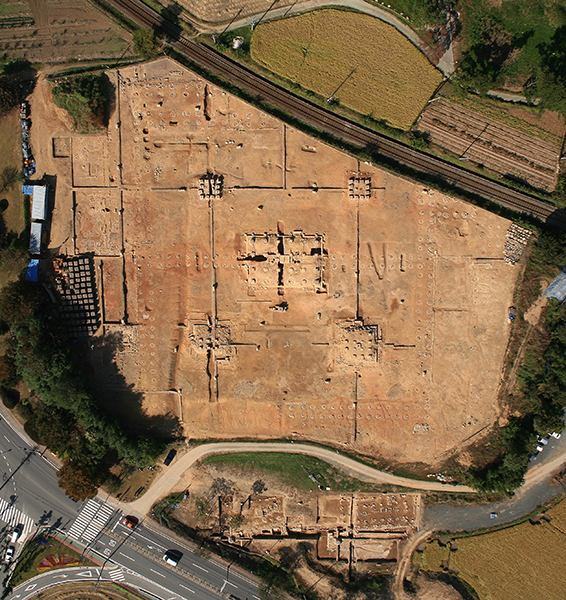
Yet on Namsan, most sites had only a single pagoda, probably due to space limits and the character of its small, hermit-like sanctuary. The T’apkok carving, therefore, can be read as an intentionally selected representation of what was then a trendy temple plan. What matters more is that while instances of monumental pagodas with seven, nine, or thirteen stories exist and examples of twin pagodas of stone are found elsewhere, Sach’ŏnwangsa and Mangdŏksa are the only monasteries known to have twin pagodas made of wood. Furthermore, they are physically close to T’apkok and certainly could be seen from the area around the monument. This is further evidence of the association between T’apkok and Sach’ŏnwangsa.
If the two pagoda reliefs to the north imply an entrance to the temple courtyard, then the two lions carved below them are better understood as guardian animals, usually found in front of a monastic compound.[100] One lion has his mouth open, while the other does not (figs. 21, 22). These mouth positions represent the two ultimate syllables in Buddhism, namely ah 阿 and hūṃ 吽. The pairing of lions as guardians of the realm can be seen in other reliefs, such as the Amitābha stele inscribed with the cyclical year Kyeyu (fig. 15) and the Amitābha stele inscribed with the cyclical year Kich’uk, both made in 670–90 (fig. 16). This suggests that the approximate date of the T’apkok monument is the late seventh century.
Finally, a Buddha hovering in midair between these pagodas seems to be a device that symbolically evokes the atmosphere of the Buddhist sanctuary (figs. 7, 7A); the Buddha doesn’t seem to be fixed anywhere, as in an actual building, but rather seems to float high above the viewer’s gaze.[101] Rather than being grounded in the composition, it works as an emblem of the Buddha’s realm that one is about to enter. The canopy, meanwhile, is reminiscent of those in śarīra reliquaries excavated from Songnimsa 松林寺 (fig. 23) and Kamŭnsa (fig. 24), again indicating contemporaneity in date.
After determining that the north side would serve as an impressive introduction and a preview to what lies behind, the craftsmen would have wanted to find a suitable use for the south side, since it had the largest horizontal expanse.[102] It is carved with a seated Buddha flanked by two bodhisattvas (fig. 8).[103] With level ground in an ample space, that side was possibly the main attraction and a primary motivation for initially choosing this site for a monument.
The southern side is the only side designed with an intentional enclosure around the deity—a frame or stage-like backdrop for the triad that makes it stand out as an enshrined statue. Previous scholarship has not addressed this feature. On the remaining three sides, figures are merely carved in bas-relief, close to the surface, but on the south side, material has been removed from the area around the deities, creating a rudimentary niche.
This feature suggests the character of the monument, since only a few sculptures have a similar enclosure. A noteworthy case is the Buddha triad at Pukchiri in Ponghwa. Although severely damaged, it includes a relief carving of a multistoried wooden pagoda, a Buddha triad, and a seated monk in a recessed niche. The posture of the triad attendants is similar to that seen in T’apkok—facing the main Buddha rather than straight ahead (fig. 17). Based on its similarity to the seated Buddha in a recessed niche (National Treasure no. 201) in nearby Pukchiri, it has been dated to the mid- to late seventh century.[104] Other sculptures from Namsan after this period are either shallow line engravings on the rock surface or completely freestanding, three-dimensional objects, without a recessed space in the relief. Thus, the south side of the T’apkok boulder can be dated to the late seventh century within the network of conventions for image making at this time.
If we compare the sculpture on the south side with the component at Sach’ŏnwangsa, for example, the southern assembly represents a head-on view of the main Buddha hall at the temple. The presence of the freestanding statue and the three-story pagoda, although enigmatic, reinforces that this configuration designates the main worship space. The standing Buddha has a well-developed voluminous body with broad shoulders, suggesting a date in the early to mid-eighth century. The feet of the Buddha and the pedestal are carved as one piece, separated from the rest of the body. This design is also found in a triad on Sŏndosan 仙桃山.[105] Although the hand gesture here is strange, because it touches the belly, it is similar to that of the headless torso of a stone Buddha from Paeri 拜里 (fig. 25) on Namsan or the eleven-headed bodhisattva statue from the Chungsaengsa 衆生寺 site on Nangsan.
Here, one should consider the presence of other objects at T’apkok and how their inclusion inflects the spatial disposition. Amid traces of what is likely a wooden shrine,[106] the three-story pagoda reconstructed from scattered fragments anchors the whole site (fig. 4).[107] The three-story stone pagoda was the most common form of monument in Unified Silla temples. The T’apkok pagoda has a single base, however, unlike pagodas with high double bases found in most other ground temples. As it sits on a mountain, on deliberately raised ground, the height of the double base may have seemed unnecessary.[108]
In the pagoda’s corresponding position west of the boulder sits another rock with a carved hole on its top, which suggests a function as a base for a stone lantern (fig. 26).[109] If so, the site would have included a three-story pagoda and a lantern stand, a balanced pair in front of the big boulder. Evidence of this pairing has indeed been found, although in fragments, at another worship site at Ch’ilburam, which dates to the early eighth century. This suggests that despite their unique reliefs and pictorial renderings, T’apkok monuments share certain aspects with other worship spaces in Unified Silla.

A visitor to this site during the Silla period would have physically beheld the north side of the boulder and mentally entered the monastery precinct. The path leads to the eastern slope on one’s left, naturally inducing ritualistic circumambulation. The east side offers the widest expanse, at thirteen meters, but is irregularly shaped due to the large difference in height between the north and south slopes (fig. 27).[110] The northern section of this eastern face is a major arena for carving and features a seated Buddha assembly with diverse figures (fig. 9). The west side of the boulder is the smallest of the four, at four meters wide, and depicts a seated Buddha and two flying deities (fig. 10). In terms of figural proportion and ornament style, it seems likely that the same artisan worked on the north and east sides, given the lean figure with a round halo with lotus petals, while the south side shows different proportions, suggesting a different hand. The figure on the west side has a relatively big head and a flame-like halo with a pointed top, also likely made by a different craftsman, and was possibly, but not necessarily, added later (fig. 28).
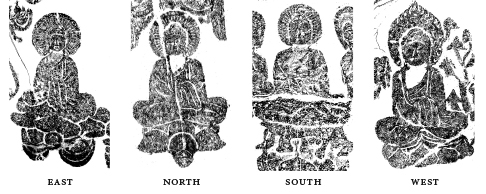
A few peculiar visual vocabularies are noticeable. First, most figures have the distinct form of a lotus throne, with a hanging part, like a tail or a drapery, under the lotus petals (figs. 8, 9). Such design is unprecedented and evokes an impression of being suspended in midair. Second, in contrast to the hovering thrones, lush trees are carved in scattered locations, to imbue the scene with a sense of the locale and the ground beneath one’s feet. The trees all take different forms and are difficult to identify, although some of them possibly indicate the Bodhi Tree (porisu 菩提樹) and Dragon Flower Tree (yonghwasu 龍華樹; Sanskrit: nāgapuṣpa) (figs. 8, 10, 29). They are rare examples of sculpted trees—an unusual motif in Silla art.[111] Third, celestial beings have diverse forms and postures, with scarves that rapidly billow in the wind, and their location is inconsistent in relation to the main figure they have come to adore. Finally, there are scattered images of monastic figures. Five are carved in different spots.[112] Interestingly, not a single monk has the same setting or posture as another, and their positions do not indicate an overall scheme governing their relation to the Buddha images.
The purpose of these images of seated monks, in particular, remains a mystery. One figure to the east sits on one knee on a rectangular mat, holding an incense burner (fig. 30). As his size clearly differs from that of other monks, he is likely a donor. In contrast to the other monks, who are rather isolated from the near scenes, he obviously belongs to the Buddha assembly above, and his posture represents homage to the deity (fig. 9). A similar arrangement is found in steles where the lower part is a space reserved for donor images. I assume a monk involved in this monument is depicted—if not Chajang or Myŏngnang, then someone of lesser standing in the hierarchy in the Silla Buddhist circle.[113] Stylistically, the monk is rendered with sophistication, and his incense burner seems similar to the one from the seventh-century stele with a pensive image and the one carried by a disciple in an image at Sŏkkuram.
Larger representations of seated monks in three-quarter view with crossed legs are found on the southeast side (fig. 41) and on a separate rock to the south (fig. 8C). They do not appear engaged in any activity other than sitting under trees. They may suggest, symbolically, the presence of monastic quarters on this rock version of a monastery.
Another category of monks includes those who appear rather formal. One to the center of the east side is seated under two exotic-looking trees (fig. 29) and looks outward. Is he the emaciated Siddhartha or a generic representation of a meditating monk? A similar monk, facing the viewer, is found to the south (fig. 8B). The robes of both monks cover their hands, and their hems protrude in the same manner as those of the Buddhas. Here, however, the lack of halos confirms that they are not deities. In ascertaining the identity of the one to the south, notice that he occupies a privileged location with no other competing images and that even the placement of the freestanding statue ensures that this image is not blocked from our view (fig. 3). Considering the priority given to this figure, he may be Mahākāśyapa, an ardent practitioner of meditation and a model of ascetic monasticism.[114] The fact that he is seated in a cave-like niche, although heavily damaged, also supports such a reading. The difficulty is that even if the figure were Mahākāśyapa, the surrounding images offer no supporting clues. Since Mahākāśyapa preserves the Buddha’s words, as symbolized by the latter’s rag robe, and transmits these words to the next Buddha, Maitreya, one would expect to see an image of either Śakyamuni or Maitreya. However, the accompanying Buddha image group provides no evidence to support such a contextual reading.
After examining all the scattered images, I concluded that they present no single narrative or any special group of deities. Even considering the irregular space offered by the hills, this haphazard placement of images in seemingly arbitrary spots gives no sense of a particular program drawn from a certain doctrine or an established assembly of selected deities. This applies not only to the overall site plan but also to individual images. Hardly any seem closely related to works outside this site, other than the double pagodas to the north.
I found, however, a surprisingly similar visual vocabulary in a group of rather unexpected objects: some small gilt bronze items from the same period.[115] They were excavated from Wŏlchi in Kyŏngju, the centerpiece of a royal palace garden constructed in 674 during King Munmu’s reign.[116] Following its excavation, a pond there yielded many types and numbers of artifacts, from everyday items to Buddhist images and paraphernalia.
These small gilt bronze items, ranging from four to nine centimeters in height, are from excavation site nos. 2, 3, and 4, and are thought to be appliqués attached to the mandorlas of Buddhist deities. The function of these items is described in a publication by Kyŏngju National Museum as “showing the splendor of the Pure Land,” since they are believed to have been ornaments for a primary deity’s realm.[117] Considerable variation exists in the images on these items: Single Buddha, Buddha Triad, Heavenly Deity, Guardian, and Precious Jewel. Since the objects are of modest scale, facial expressions are abbreviated, and only the essence of features is represented.
The images on the appliqués precisely match the relief carvings at T’apkok. Similarities include a multistoried pagoda with pendant bells below the eaves (fig. 31), an asymmetrical arrangement of one seated Buddha with only one kneeling attendant (fig. 32), the presence of a canopy above a selected Buddha’s head (fig. 33), and a triad with two attendants looking toward a central Buddha rather than in a frontal gaze (fig. 34). Some Buddhas in the Wŏlchi appliqués look just like the T’apkok Buddhas, even down to the peculiar placement of both hands covered by the hems of their robes. The strange-looking tail attached to the lotus throne of some deities at T’apkok now can be understood as a cloud pattern, hinting at the ascent or hovering of all the images. The uniquely rendered flying figure located in the upper right of the east Buddha assembly at T’apkok—which shows only the upper half of a frontal body holding a lute in a foreshortening method (fig. 35)—is echoed in the small bronze appliqué from Wŏlchi (fig. 36). Significantly, Wŏlchi is located just north of Namsan, at a distance similar to that of Sach’ŏnwangsa from Namsan, and is possibly of the same period (fig. 37).
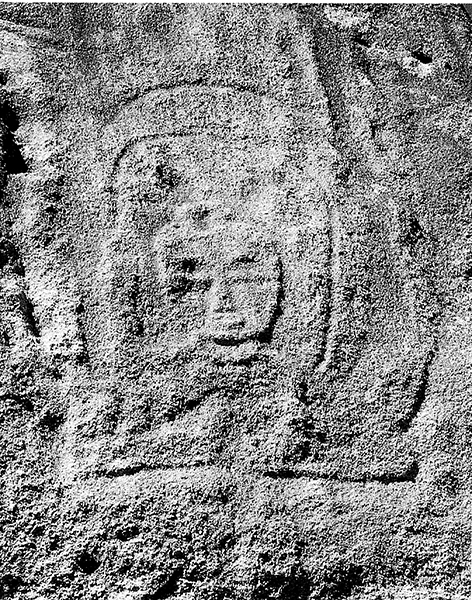
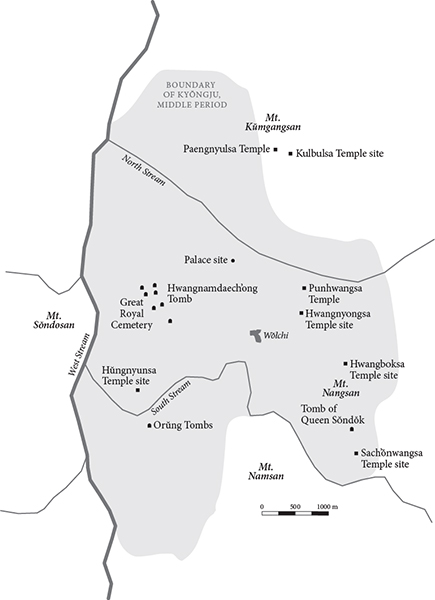
Interestingly, most of these small mandorla attachments are from excavation site no. 3, where a pair of bronze ears was also found.[118] Based on the ears’ size, it has been suggested that the biggest statue, now lost, was once enshrined there.[119] Most of the bronze statues were discovered at another site, no. 4. These finds indicate that sites 3 and 4 were likely Buddhist shrines. In addition to the appliqués, site no. 4 yielded a single seated Buddha statue of modest size (fig. 38). Because the figure is hunched forward, it must have been attached to the upper part of a large mandorla.[120]
A visual affinity with the T’apkok carving also is found in objects excavated from another temple, Sŏkchangsa in Kyŏngju.[121] Clay tiles were excavated at this site, on which patterns of multistoried pagodas alternate with seated Buddhas (fig. 39). Intriguingly, both the pagodas and the Buddha’s mudra are remarkably similar to those of the T’apkok carving. Even more interestingly, the famous monk/sculptor Yangji, who was responsible for making tiles at Sach’ŏnwangsa, likely was involved in crafting these clay tiles.[122] Yangji, who lived at Sŏkchangsa, reputedly had the mysterious ability to control a monastic staff that flew by itself and collected monetary donations for the temple.[123] Sŏkchangsa took its name from Sŏkchang, meaning a “monastic staff,” as if to testify to Yangji’s association with the temple.
These remarkable similarities are hard to comprehend. The object of our discussion is a huge boulder, while these smaller items are appliqués attached to a mandorla or small clay tiles. However, although the connection is tenuous, it bears further examination. On the one hand, it is possible that the T’apkok carving represents a random adoption of imagery common at the time. The corpus of contemporaneous works, in other words, might have functioned like a storage cupboard, filled with usable motifs; when meaning was not at stake, the designer could choose what he liked based on, for instance, visual familiarity or personal taste, whether his own or the patron’s. In this case, Wŏlchi or Sŏkchangsa’s motifs and T’apkok’s imagery, although visually similar, would not share meaning or visually reference one another beyond incorporating Buddhist deities in a similar time frame.
On the other hand, it might suggest that the T’apkok monument was intended to be understood as an integrated site, one that functioned to embellish something grander by adopting the visual devices found on the minute appliqués or tiles. Just as the small gilt bronze items are not the central piece on their own but rather complement something greater, the relief carving here anticipates a more significant entity. Whether it was a hidden śarīra reliquary, a now-lost Buddha that originally stood in front of the boulder, a treasured icon inside a wooden shrine, or the center of the boulder itself symbolizing the ultimate Buddha-nature in combination with the indigenous rock cult, the T’apkok monument seems to function as a preview, a wrapper, or something that frames what lies behind, in front, below, or above. The T’apkok monument, essentially, embellishes and presents the resplendent Buddha Land by garnishing its central existence—icon, śarīra, rock, or abstract entity—efficaciously and succinctly.
In sum, the T’apkok monument drew from resources beyond Sach’ŏnwangsa, which offers the most relevant parallel based on its physical proximity, its similar time period, the twin pagodas, and Myŏngnang’s involvement. Sŏkchangsa provides points of comparison in terms of visual motifs, which may have been made in Yangji’s workshop. Wŏlchi, although not exclusively Buddhist in nature, suggests the pervasiveness of the ornamental vocabulary of Buddhist imagery. The adjacent site of Namgansa on Namsan, on the other hand, provides a crucial link between the Chajang and Mŏngnang family and the T’apkok monument.
Remember that in contemporaneous Tang China, there are comparable cases that combine a prestigious monastery on the land with carvings on adjacent hillsides. For example, close to the magnificent Shentongsi 神通寺, imperial family members of the Tang and local prefects commissioned Buddhist images to be carved on the nearby hillside, resulting in the formation of the rock carving known as the “Thousand Buddha Cliff.”[124] The Shentongsi was claimed to be “revered by the entire world” in its heyday, and indeed it received gifts from kings of a number of rival states.[125] Unified Silla’s Sach’ŏnwangsa was no less impressive, so the presence of the T’apkok carvings may suggest a similar homage. Patrons and craftsmen involved in constructing and furnishing Sach’ŏnwangsa may have produced the unique imagery on the sacred mountain at T’apkok as well.
Another rock carving illustrates my point. Discovered in 1994 by a local resident at Paebandong 排盤洞 on Namsan, 500 meters northeast of T’apkok, it features such motifs, albeit heavily eroded, as a five-story wooden pagoda and a seated Buddha under a canopy, its hands covered by robes.[126] These motifs and the carving’s overall pictorial rendering suggest it is a modestly scaled imitation of or local response to the T’apkok monument. However, the level of artistic achievement, in terms of simpler rendering and lack of dynamic energy, differs from that of T’apkok. We can surmise that someone with lesser means tried to emulate the T’apkok carving later and sponsored the Paebandong monument.
Given the sophisticated style of the terra-cotta guardians from Sach’ŏnwangsa, the T’apkok sculpture appears modest, perhaps even naïve. Yet finding a stylistic disparity in nearby monuments is not uncommon, especially considering that Wŏlchi, for example, had exquisite bronze plaques of the Buddha triad with updated mudras, sumptuous volume, and realistic body contours (fig. 40), but also more modest bronze appliqués of lesser spectacles. The tantalizing interplay between the center and the periphery, the big and the small, and the original and the replica can be teased out when one looks at the T’apkok monument.
The natural terrain and the shape of massive rocks determine the acts of carvers and viewers. The carvers must have completed a sort of circumambulation in the very act of planning and carving. From the viewer’s perspective, the monument acts as if it were a rock version of a monastery precinct. After marveling at the front gate and its two pagodas, one is invited to climb to the eastern side. The seated monk on a separate rock at the south end of the east side (figs. 41, 41A) looks to the south, as if leading the visitor’s gaze and footsteps, and a guardian figure on the back of the same rock (figs. 42, 42A) invokes the sense of entering a space sanctified for worship. On the guardian image’s left side is a narrow path on a steep hill, like a throughway, leading to the south plateau and recreating a symbolic initiation (fig. 43).
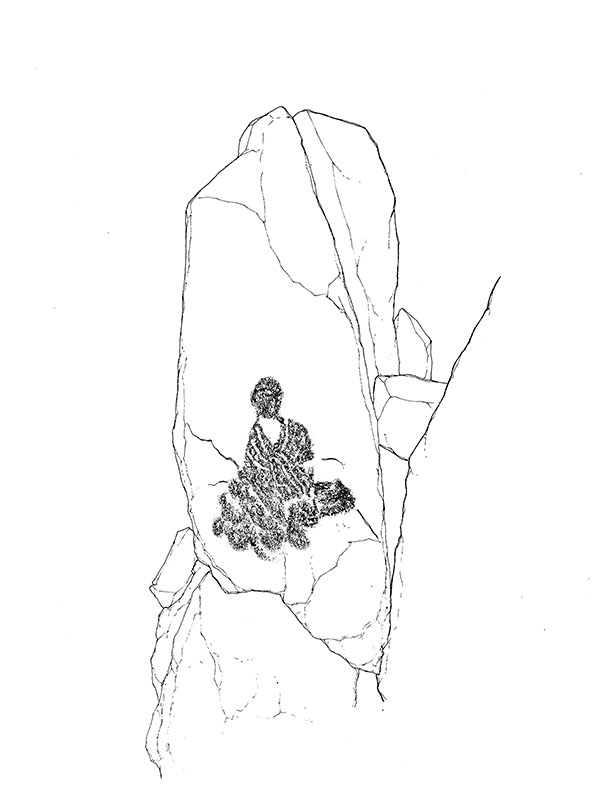

The path is obvious. Climbing to the hill and staying south for a period of reflection and veneration, one is enclosed within the temple proper, seemingly defined by the stone lantern and freestanding pagoda. After observing the Buddha assemblies, one can complete the circumambulation of the boulder by returning to the conceptual entrance/exit, framed by the engraved pagoda reliefs to the north. If one decides to continue on to the top of the mountain, the west side is left unseen. This is perhaps why only the Buddha image on the west side has a different form and style; it suggests that it either was left uncarved during the first phase or was crafted by a different hand. Guided by the shape of the land and the boulder’s imagery, the devoted aspiration of the Buddha Land is fulfilled by the simple act of climbing, walking, and viewing at T’apkok.
The ongoing conversation between the mountainous setting and the manmade images suggests the performative role these places and objects played in shaping and transforming the visual and religious experience of devotees. I believe this sculptural grouping is an exemplary case of tripartite and reflexive agency involving natural features, carved images, and believers’ devotional acts.
V. Epilogue
On Namsan, no single peak reigns over others; no peak or valley is dominated by a higher peak or a deeper valley—each has its own character. Approximately sixty valleys and many more peaks of various sizes compose this Buddha mountain, where organically connected paths and myriad rock faces create modest wonders.
Fortunately, here we can peek into the Silla Buddhists’ idea of the Buddha Land. It was often subtle, embedded in an indigenous belief in rocks and mountains or enlivened by sporadically carved images of the divine, while at other sites, it was physically manifested in a concentrated temple compound, such as Pulguksa, which literally means the “Monastery of the Buddha Land.”
The Silla Buddhists’ exaltation of Nangsan as Mount Sumeru and of Sach’ŏnwangsa as the heavenly abode of Four Guardians provides insight into the T’apkok monument. T’apkok presents another dimension; it is close enough to have a majestic view of Sach’ŏnwangsa but distant enough from the hustle and bustle of the capital city to allow for reflection. Its location on Namsan, sitting above the Dragon Pool but remaining within reach of major royal and aristocratic sites, is pivotal. The boulder itself was a source of mysterious power, and the flat ground was a bonus. By embellishing the rock with carved images of deities, the T’apkok monument attained, in a truly unique fashion, a composite of the world at hand, with its imperfections, and the longed-for world of the Buddha Land.
Author’s Note
An earlier version of this paper was presented at the 2013 Korean art history workshop “Infinite Interfusion: Buddhist Art in Korea,” Harvard University. I am thankful to the organizer and the panel discussants for such a stimulating workshop. I also thank two anonymous reviewers for their meticulous reading and useful suggestions; their comments helped me reformulate some of the issues for discussion. I thank Dr. Michelle Wang, Dr. Wei-Cheng Lin, and Dr. Yoko Shirai for their insights on the manuscript. For the transliteration of Korean names and texts, I have used the McCune-Reischauer system except for words with established spellings, such as Seoul, and for some modern scholars’ and museums’ names given how they transliterate their own names.For Buddhist texts available in Chinese translation, I have used the Pinyin system to transliterate their titles. Unless otherwise noted, all translations are mine.
Notes
Namsan is a collective term for the hills and valleys of Kŭmosan金鰲山 (468 meters) and Kowisan 高位山 (494 meters) in Kyŏngju, the capital during both the Old Silla (57 BCE–668 CE) and the Unified Silla (668–935 CE) periods. In contrast, Namsan 南山, located in present-day Seoul, is translated in most Anglophone scholarship as “Mount Nam.” Thus to distinguish between these two, I will, here, refer to the one under current discussion according to its original transliteration: “Namsan.”

To understand the special status of Namsan in Silla culture, see Kang Ubang (Kang Woobang), “Kyŏngju Namsan ron,” Wŏnyung kwa chohwa (Seoul: Yŏrhwadang, 1990), 387–91, originally published as Kyŏngju Namsan (Seoul: Yŏrhwadang, 1987); Sunkyung Kim, “Awakened, Awaiting, or Meditating? Readdressing a Silla Period Image from the Buddha Valley on Mount Nam,” Journal of Korean Studies 16, no. 1 (spring 2011), 120–21.

The sanctuary seems to have historically been known as Ongnyongam, and local residents still prefer this name over its current official name, Pulmusa 佛無寺, which refers broadly to the monastery and a few small buildings nearby.

Some scholars have different ideas about its exact date. For the theory supporting the late sixth century, see Kim Lena, Buddhist Sculpture of Korea (Seoul: Hollym, 2007), 39–40. For those supporting the early to mid-seventh century, see Mun Myŏngdae, “Silla sabangbul ŭi kiwŏn kwa Sininsa ŭi sabangbul,” Han’guksa yŏn’gu 18 (1977), 49–75; Mun Myŏngdae, Han’guk chogaksa (Seoul: Yŏrhwadang, 1980), 156; Kim Kirung, “Kyŏngju Namsan T’apkok chosanggun e taehayŏ,” Silla munhwa 5 (1988), 129–60. For the early eighth century, see Kim Hyŏnju, “Kyŏngju Namsan T’apkok chosanggun yŏn’gu” (MA Thesis, Ehwa Woman’s University, 2000), 60. For the theory supporting the ninth century, a much later date, see Kang Ubang, “Kyŏngju Namsan ron,” 396–97. Kwak Tongsŏk suggests different dates for each component: mid-seventh century for the north side of the boulder, sometime later for the other three sides, late eighth century for a freestanding statue, and ninth century for the stone pagoda. Kwak Tongsŏk, “Namsan yujŏk pulsang koch’al,” in Kyŏngju Namsan ŭi pulgyo yujŏk III—Tongnamsan saji chosa pogosŏ (Kungnip Munhwajae Yŏn’guso: 1998), 233.

Oba Tsunekichi simply states that the unprecedented images at T’apkok are hard to identify but might collectively be scenes from the Buddha’s life 佛傳 or Transformation Tableau 變相圖. Oba Tsunekichi, “Keishū Nanzan no busseki,” Keishū Nanzan no busseki, ed. Chōsen Sōtokufu (Keijō: Chōsen Sōtokufu, 1940), 67.

Mun Myŏngdae, “Silla sabangbul,” 70–75; Kim Kirung, “Kyŏngju Namsan T’apkok chosanggun,” 129–34.

There is a substantial body of scholarship on the pulgukt’o ideal in Silla Buddhism. Among these works, seminal work was conducted by the late Professor Yi Kiyŏng (Rhi Ki-yong) 李箕永, “7–8 segi Silla mit Ilbon ŭi pulgukt’o sasang- sanak sungbae wa sabangbul,” Han’guk chonggyosa yŏn’gu 2 (1973), 1–42. For Japanese and English articles by the same author, see Yi Kiyŏng, “Shōchōteki hyōgen o tōshite mitaru shichi hasseki Shiragi oyobi Nihon no bukkokuto shisō,” in Shiragi to Asuka-Hakuhō no Bukkyō bunka, ed. Tamura Enchō and Hong Sunch’ang (Tokyo: Yoshikawa Kōbunkan, 1975), 1–44; Rhi Ki-yong, “Brief Remarks on the Buddha-land Ideology in Silla during the Seventh and Eighth Centuries,” trans. Antonino Forte, in Tang China and Beyond: Studies on East Asia from the Seventh to the Tenth Century, ed. Antonino Forte (Kyoto: Istituto Italiano di Cultura Scuola di Studi sull’Asia Orientale, 1988), 163–79. For a relatively recent discussion of the Western scholarship about the pulgukt’o ideal and Silla Buddhism in general, see Richard D. McBride, Domesticating the Dharma: Buddhist Cults and the Hwaŏm Synthesis in Silla Korea (Honolulu: University of Hawai‘i Press, 2008).

King Chinp’yŏng took the name Paekchŏng 伯淨, after Śākyamuni’s father, and gave his wife the name Maya摩耶 after Śākyamuni’s mother.

The name Sŏndŏk善德 is thought to have been taken from “brāhman Chande 婆羅門善德” in Dafangdeng wuxiang jing 大方等無想經 (Mahāmegha Sutra). Takakusu Junjirō and Watanabe Kaigyoku, eds., Taishō shinshū daizokyō (hereafter T.) (Tokyo: Taishō issaikyō kankōkai, 1924–32), 387, 12: 1095a.

Yun Kyŏngnyŏl briefly mentions that the T’apkok monument is like a mandala, whose abbreviated form represents the Four Directional Buddhas and whose center represents the Vairocana Buddha. He also states that the rock itself is a Buddha hall (pŏptang 法堂). Yun Kyŏngnyŏl, Kyŏngju Namsan ŭi T’apkol (Seoul: Yorhwadang, 1991), 28, 58. While I largely agree that the rock serves a function similar to that of a Buddha hall, the main boulder symbolically includes other components of a monastery as well, and its interpretation as the Four Directional Buddhas should be reassessed. See the next section.

Oba Tsunekichi, “Keishū Nanzan no busseki,” 67. Regarding Mr. Ōsaka, see my discussion later in this chapter.

Mun Myŏngdae, “Silla sabanggul,” 70–74; Kim Kirung, “Kyŏngju Namsan,” 12–13; Yun Kyŏngnyŏl, Kyŏngju Namsan, 65–70.

Henrik H. Sørensen, “On the Sinin and Ch’ongji Schools and the Nature of Esoteric Buddhist Practice under the Koryŏ,” International Journal of Buddhist Thought and Culture 5 (2005), 49–84; Kim Poksun, “Samguk yusa Myŏngnang Sinin cho ŭi kusŏng kwa Sininjong sŏngnip ŭi munje,” Silla munhwaje haksul palp’yo nonmunjip 32 (2011), 201–28; Kim Suyŏn, “Koryŏ sidae milgyosa yŏn’gu” (Ph.D. diss., Ehwa Womans University, 2012). For recent discussions on esoteric Buddhism in East Asia, see Charles D. Orzech, Henrik H. Sørensen, and Richard K. Payne eds., Esoteric Buddhism and the Tantras in East Asia (Leiden and Boston: Brill, 2011).

T. 2039, 49: 1011b. There has been much debate regarding the adequacy of using Samguk yusa records compiled by the Koryŏ dynasty monk Iryŏn 一然 (1206–1289) and their historical reliability for studying earlier periods. For further discussions, see Yi Kibaek, “Samguk yusa ŭi sahaksajŏk ŭiŭi, Chindan hakpo 36 (1973), 162–65; Henrik Sørensen, "Problems with Using the Samguk yusa as a Source on the History of Korean Buddhism," Cahiers d'Études Corénnes 7 (2000), 270–86; Henrik Sørensen, “Early Esoteric Buddhism in Korea: Three Kingdoms and Unified Silla (ca. 600–918),” in Esoteric Buddhism and the Tantras in East Asia, 576–96. Yet as Iryŏn and other possible participants in the compilation process relied on several texts that are now lost, this is the most important text to offer substantial information on the Three Kingdoms and Unified Silla periods. The literary style also indicates that it was a selective, edited compilation that owed its existence to various antecedents, including monastic biographies, “sajung(yu)gi 寺中(有)記 (record from the monastery),” as well as “ko hyangjŏn 古鄉傳 (old local tale),” rather than the authors’ own creation. More promisingly in this light, recent fruitful discussions have positively validated the use of Samguk yusa documents by comparing them to external/internal texts and epigraphical and archaeological remains. For details, see Youn-mi Kim, “(Dis)assembling the National Canon: Seventh-Century ‘Esoteric’ Buddhist Ritual, the Samguk yusa, and Sach’ŏnwang-sa,” in New Perspectives on Early Korean Art: From Silla to Koryŏ, ed. Youn-mi Kim (Cambridge: Harvard University, 2013), 123–91.

T. 2039, 49: 972b; T. 2039, 49: 1011b. Another account mentions Myŏngnang performing a ritual during which another monk, Hyegong 惠空, appeared without wet clothes and shoes following heavy rain. This account, however, says more about Hyegong than Myŏngnang; T. 2039, 49: 1005a.

Sagan 沙干 is Sach’an 沙飡, the eighth official rank among the seventeen ranks of Silla officialdom. Han’guk Chŏngsin Munhwa Yŏn’guwŏn, Yŏkchu Samguk yusa 4 (Seoul: Ihoe Munhwasa, 2003), 227.

Sop’an 蘇判 is Yŏngch’an 迎飡, the third official rank among the seventeen ranks of Silla officialdom; Yŏkchu Samguk yusa 4, 228.

T. 2039, 49: 1011b. Ŭian taedŏk is recorded to have held a high position in charge of Buddhist temples and other religious institutions in the fourteenth year of King Munmu’s reign, dated 674. Kuksa P’yŏnch’an Wiwŏnhoe, Han’guksa Database, Samguk sagi, http://db.history.go.kr/item/level.do?levelId=sg_032, accessed October 2014. For the term taedŏk, expounded in Genben shuo yiqie youbu pinaye zashi 根本說一切有部毘奈耶雜事 38, see T. 1451, 24: 399a. The practice of bestowing such titles on monks began in the Buddhist society of Tang China and influenced Silla practices. In the Koryŏ period, the title bhadanta was the rank given to monks who successfully completed the regular course of monastic examinations (taesŏn 大選). I thank the anonymous reader for providing this important information.

In both accounts in the Samguk yusa, it says “[Myŏngnang] entered the Dragon Palace [and] transmitted [taught] the secret method. T. 2039, 49: 972b; T. 2039, 49: 1011b. In another account about a monk, Hyet’ong, Myŏngnang is said to have entered the Dragon Palace and acquired Sinin. “入龍宮得神印 (T. 2039, 49:1011a).” The claim that there was a connection to the Dragon Palace may have increased the perceived value of his special method, given its possible origin in an exotic place like India, the homeland of Buddhism; Kim Poksun, “Samguk yusa Myŏngnang,” 210–15. At the same time, it could have been an effort to appropriate the legends of Nāgârjuna 龍樹 (circa 2nd–3rd century) or Śubhakarasiṃha 善無畏 (637–735); Pak T’aehwa, “Silla sidae ŭi milgyo chŏnnae ko,” Hyosŏng Cho Myŏnggi paksa hwagap kinyŏm pulgyo sahak nonch’ong (1965), 69–70. Yet, it is equally possible that the connotation of the Dragon Palace was more specifically about Silla’s own site. This is plausible for two reasons: first because Dragon Palace South 龍宮南 for Hwangnyongsa 皇龍寺 and Dragon Palace North 龍宮北 for Punhwangsa 芬皇寺 are mentioned in the Samguk yusa as likely locations of some of the Seven Monasteries of Past Buddhas, which had been recorded as existing in the royal capital (T. 2039, 49: 986b); and second because several other accounts exist of the dragon association in Silla’s state temples, such as Hwangnyongsa and Kamŭnsa 感恩寺. For Hwangnyongsa, see section IV of this essay. The archaeological excavation at the Kamŭnsa site confirms that an underground space exists beneath the main hall where, following King Munmu’s will, the dragon, as the king’s reincarnation, could enter the monastery. T. 2039, 49: 973a. Another small but interesting point is that in Myŏngnang’s account the Dragon Palace seems to designate a place located “on the way home from China,” as seen in the expression “[When he was] about to return [home], he entered the Dragon Palace at the request of the Dragon King”; T. 2039, 49: 1011b. Therefore, it is unlikely, if not entirely impossible, that the Dragon Palace described here was located in India or another distant country.

T. 1331, 21: 515a–16c; Makita Tairyō, Gikyō kenkyū (Kyoto: Kyoto Daigaku Jinbungaku Kenkyūsho, 1976), 14; Michel Strickmann, “The Consecration Sutra: A Buddhist Book of Spells,” in Chinese Buddhist Apocrypha, ed. Robert E. Buswell Jr. (Honolulu: University of Hawai‘i Press, 1990), 75–118.

T. 2039, 49: 972b. Kim Poksun, “Samguk yusa Myŏngnang,” 217.

For a detailed discussion on the Munduru ceremony and its connection to the Sach’ŏnwangsa, see Youn-mi Kim, “(Dis)assembling the National Canon.” For a more general explanation on the relationship between Buddhism and the state in Silla, see Richard D. McBride, Domesticating the Dharma, 13–32.

The Tang made another attempt the following year with fifty thousand troops but met the same end when Myŏngnang repeated the process. The Munduru ceremony was understood to be drawn from shamanistic practice, particularly in its use of astronomical and meteorological factors that were believed to be essential to the war effort. Kim Poksun, “Samguk yusa Myŏngnang,” 221.

Kim Sanghyŏn, “Sach’ŏnwangsa ŭi ch’anggŏn kwa ŭiŭi,” Silla wa Nangsan (Kyŏngju: Silla Munhwa Sŏnyanghoe, 1996), 125–44. Some scholars have argued convincingly that the unusual stone installations discovered behind the main hall at the site of Sach’ŏnwangsa may have been used for the Munduru ceremony. Chang Ch’ungsik, “Silla Nangsan yujŏk ŭi che munje (I) Sach’ŏnwangsa rŭl chungsimŭro,” Silla munhwaje haksul palp’yohoe nonmunjip 17 (1996), 15–36; Chang Ch’ungsik, “Silla Sach’ŏnwangsaji tansŏk ŭi koch’al,” Pulgyo hakpo 39 (2002), 7–23; Youn-mi Kim, “(Dis)assembling the National Canon,” 150–77. Since Myŏngnang is credited with having performed the very first Munduru ceremony—one that was viewed as effective, according to textual accounts and supported by material remains—it seems plausible that his role in establishing esoteric Sininjong was critical.

Kang Ubang, “Kyŏngju Namsanron,” 396. Kim Hyŏnju, “Kyŏngju Namsan T’apkok,” 55–57.

Bricks, green-glazed clay tiles of guardians, and the pagoda foundations were discovered at the site, and their exquisite details include the most minute iconography; this testifies to the highest level of artistic achievement that could be found at that time. Among those, the terra-cotta tiles of armored guardians have been considered to be those described in the Samguk yusa, where it was recorded that a sculptor named Yangji 良志 made images of the Eight Guardians under a pagoda at Ch’ŏnwangsa 天王寺, believed to represent Sach’ŏnwangsa; T. 2039, 49: 1004a. Regarding their identification, i.e., whether they are Four Heavenly Kings (sach’ŏnwang 四天王), Eight Kinds of Being (p’albujung 八部衆), Spirit Kings (sinwang 神王), or Guardian Generals (sinjang 神將), see Kang Ubang, “Sach’ŏnwangsaji ch’ult’o c’aeyu sach’ŏnwang pujosang ŭi pokwŏnjŏk koch’al,” Wŏnyung kwa chohwa, 159–201, originally published in Misul charyo 25 (1979); Im Yŏngae (Lim Youngae), “Sach’ŏnwangsaji sojosang ŭi chonmyŏng,” Misulsa nondan 27 (2008), 7–37; Youn-mi Kim, “(Dis)assembling the National Canon,” 150–77. For general discussion on Yangji’s works, see Kang Ubang, “Sin Yangji ron,” Pŏpkong kwa changŏm (Seoul: Yŏrhwadang, 2000), 147–62, originally published in Misul charyo 47 (1991). Measuring about 90 × 70 cm, each likely functioned as a side panel on the pedestals of the two wooden pagodas.

Sŏngjŏn offices ranked highly in the overall apparatus of the Silla state; specifically, they ranked fifth among the 160 state institutions described in the Samguk sagi, higher than many offices of ministerial rank. Sergei Vladimirovich Volkov, “State and Buddhism in the East Asian Countries in the Early Middle Ages,” in Korean Buddhism in East Asian Perspectives, ed. Geumgang Center for Buddhist Studies (Seoul: Jimoondang, 2007), 54–56.

T. 2039, 49: 986b. For Hwangnyongsa ch’alchu pon’gi 皇龍寺剎柱本記, dated 872, see Han’guk Kodae Sahoe Yŏn’guso ed. Yŏkchu Han’guk kodae kŭmsŏngmun 3 (Seoul: Karak-kuk Sajŏk Kaebal Yŏn’guso, 1992), 364–75; Hwang Suyŏng, “Silla Hwangnyongsa Kuch’ŭngt’apchi: Ch’alchu pon’gi e taehayŏ,” Misul sahak yŏn’gu 116 (1972), 275–77.

The character 虎 (ho) or 茂 (mu) is used instead of 武 (mu) to avoid the same character used in King Hyejong 惠宗’s name in Koryŏ.

Kungnip Kyŏngju Munhwajae Yŏn’guso, Kyŏngju Namsan - top’anp’yŏn (Kyŏngju: Kungnip Kyŏngju Munhwajae Yŏn’guso, 2000), 87–88. For its association with Lady Namgan, see Kim Poksun, “Samguk yusa Myŏngnang,” 211, 228; Kang Ubang, “Kyŏngju Namsanron,” 388.

T. 2039, 49: 1011 b. The name Kŭmgwangsa, meaning “Gold Light Monastery,” originated from the gold embellishment on the pagoda and Buddha images. For the confusion between the names Kŭmgwangsa, Kŭmgangsa 金剛寺, and Kŭmiksa 金羽寺 and their connection to the sutra Jin’guangming jing 金光明經, see Kim Poksun, “Samguk yusa Myŏngnang,” 208–9. A similar example of a monk donating a large sum of money or property inherited from his own family to a Buddhist temple can be found in some epigraphic documents. For example, the stone stele for the Great Master Chijŭng 智證大師, written by Ch’oe Ch’iwŏn 崔致遠 in 893 (erected in 924), now at the Pongamsa 鳳巖寺 in North Kyŏngsang province, states that he donated five hundred kyŏl of land to the monastery. Considering that Chijŭng left home at the age of nine and entered the saṃgha by taking the full precepts at seventeen, the property he donated was from his own family. Yi Chigwan, Kyogam yŏkchu yŏktae kosŭng pimun: Silla p’yŏn (Kasan mun’go, 1994), 280–338.

Kungnip Kyŏngju Munhwajae Yŏn’guso, Kyŏngju Namsan, 85–89. Another monk, Hyet’ong 惠通 (n.d.), who reportedly performed esoteric rituals in the period of time after Myŏngnang, was known to have lived in a village near Namgansa on the western foot of Namsan. T. 2039, 49: 1010c.

Regarding the history and use of archaeological survey photographs and archival colonial registry data that describe the ancient remains of Chosŏn, commissioned by the Colonial Government-General of Chōsen Office and Museum (Chōsen Sōtokufu hakubutsukan), see Pai Hyung Il, “Tracing Japan’s Antiquity: Photography, Archaeology and Representations of Kyŏngju,” in Oriental Aesthetics and Thinking: Conflicting Visions of “Asia” under the Colonial Empires (Kyoto: International Center for Japanese Studies, 2011), 289–316.

Among scholars who accepted the Sininsa roof tile as reliable, only Yun Kyŏngnyŏl mentioned that “Mr. Ōsaka” had been head of Kyŏngju Museum under the Japanese Colonial Government General Office. Yun Kyŏngnyŏl, Kyŏngju Namsan, 6. However, Yun provided further details neither on Ōsaka’s full name nor on his other research on Silla art. Mun Myŏngdae simply introduced the discovery without mentioning Ōsaka. Mun Myŏngdae, “Silla sabangbul,” 73. Kim Hyŏnju briefly acknowledged him but expressed doubts about this information based on the lack of photos. Kim Hyŏnju, “Kyŏngju Namsan T’apkok,” 56.

Some of his representative works include Ōsaka Kintarō, Shiragi kyūto Keishū koseki annai (Keijō: Chōsen Sōtokufu, 1926); Ōsaka Kintarō, Keishū koseki oyobi ibutsu chōsho (Keijō: Chōsen Sōtokufu, 1931).

Kim Tongha, “Ilje kangjŏmgi ŭi Kyŏngju chiyŏk pulgyo yujŏk chosa wa Kyŏngju kojŏk pojonhoe ŭi Keishū koseki oyobi ibutsu chōsho (慶州古蹟及遺物調書),” Pulgyo misulsahak 15, no. 3 (2013), 205–33.

Ōsaka, as head of the museum, stored this stone tablet in Kyŏngju Branch Museum without conducting additional research. Suematsu Yasukazu 末松保和, then a history professor at Keijō Imperial University, published a short research article after his visit to the museum. Suematsu Yasukazu, “Keishū shutto no Jinshin Seikiseki ni tsuite,” Keijō Teidai sigaku kaisi (1936), 1–5. Later in 1967, Ōsaka published an article, “Shiragi Karō no Seikiseki,” Chōsen gakuho 43 (1967), 121–28.

Mun Myŏngdae, “Silla sabangbul,” 49–75; Kim Kirung, “Kyŏngju Namsan,” 2–6; Yun Kyŏngnyŏl. Kyŏngju Namsan, 23–70.

Yun Kyŏngnyŏl, Kyŏngju Namsan, 23–64; Mun Myŏngdae, “Silla sabangbul,” 71–73. The identities of the so-called Four Directional Buddhas, however, remain under debate, with ongoing confusion among modern Buddhologists over their identities as well as their historical origin in Buddhist texts and contemporaneous monastic writings. For a list of the different Buddhas assigned to each direction by different texts, see Kim Rina (Kim Lena), “Kyŏngju Kulbulsaji ŭi samyŏn sŏkpul e taehayŏ,” Han’guk kodae pulgyo chogaksa yŏn’gu (Seoul: Ilchogak, 1989), 241, originally published in Chindan hakpo 39 (1975).

Mun Myŏngdae, “Silla sabangbul,” 70–74; Yun Kyŏngnyŏl, Kyŏngju Namsan, 23–64. The most frequently cited textual sources used to identify the four members include Jin’guangming jing (Suvarṇa-prabhāsa-sūtra) (T. 663, 16: 335b, 345c), and Guanfo sanmeihai jing 觀佛三昧海經 (Sūtra on the ocean of samādhis for visualizing the Buddha, or the Ocean-like Samadhi Sutra) (T. 643, 15: 688c, 689a; Yi Sukhŭi (Lee Suk-hui), “T’ongil Silla sidae obangbul ŭi tosang yŏn’gu,” Misulsa yŏn’gu 15 (2002), 3–44. Some later texts, such as the Tuoluoni ji jing 陀羅尼集經 (Dhāranī Collection), developed esoteric Five Directional Buddhas (T. 901, 18: 894c), while the Bukong juansuo shenbian zhenyan jing 不空羂索神變眞言經 places Vairocana Buddha as the central figure among the five Buddhas and identifies a different mudra for each (T. 1092, 20: 270a–c). Among all these different combinations of Buddhas, the most consistently referenced members are those of the east, Akṣobhya, and of the west, Amitāyus. Given that such Buddhas as Akṣobhya, Ratnaketu, and Madhura-svara-nirghoṣa were not very popular in Korea, especially in Unified Silla, one wonders whether they were actually associated with a certain direction. One might even argue that the Four Directional Buddhas were only described in texts, while actual sculpture was more or less a collection of the four popular Buddhas in a single object. One support for this line of thought is the habitual inclusion of the image of Bhaiṣajya-guru (Yaoshi 藥師) as the deity to the east, as is seen in many later examples, rather than the adoption of Akṣobhya for that direction, as specified in textual sources. Meanwhile, a Chinese stele of the Eastern Wei (535) at Shaolinsi 少林寺in Henan province is a notable example that confirms that a specific combination of Buddhas was sometimes based on particular texts. A more complete representation of four/five directional Buddhas based on the esoteric practice is observed in the ninth century; Eugene Wang, “Of the True Body,” in Body and Face in Chinese Visual Culture, ed. Wu Hung and Katherine R. Tsiang (Cambridge and London: Harvard University Press, 2005), 104–8.

The interesting story of Prince Poch’ŏn and Hyomyŏng’s encounter with Buddhist deities on Odaesan 五台山 in Samguk yusa introduces the idea of a different group of deities for each direction. T. 2039, 49: 998c–999a. Yi Sukhŭi, “T’ongil Silla,” 19–20.

The text records the date as “the ninth year of King Chinp’yŏng, the cyclical year of Kapsin 甲申.” The ninth year of King Chinp’yŏng corresponds to the year 587, but it is the year of Chŏngmi 丁未, rather than Kapsin. If one uses the year Kapsin, the year would be 624. Some scholars have questioned both of these early dates, suggesting instead an eighth-century date. Yi Sukhŭi, “T’ongil Silla,” 20.

The combination of seated and standing Buddhas on a single boulder is typical of similar sculptures. The one at Hwajŏn-ri 花田里 in Yesan is probably the earliest image of its kind that remains from the old Paekche kingdom. Another candidate for the earliest image of Four Directional Buddhas is the Nŭngjit’ap or “pagoda-shaped tomb” on Nangsan, dated to the seventh century. For further information, see Kang Ubang, “Nŭngjit’ap sabangbul sojosang,” Pŏpkong kwa changŏm, 164–83, originally published in Silla munhwaje haksul palp’yohoe nonmunjip 17 (1996). Ch’ilburam 七佛庵 on Namsan, on the other hand, is an early eighth-century monument built from a squarish boulder carved with four seated Buddhas; beyond it is a half-dome rock with a Buddha triad placed behind almost like a backdrop.

Kim Rina, “Kyŏngju Kulbulsaji,” 246, 265. This being the case, its title, described as “Four Directional Buddhas” in the Samguk yusa, can be better understood as Four-Sided Buddhas (samyŏnbul 四面佛). T. 2039, 49: 991b. This same indeterminacy might well apply to any square-shaped boulder with an inconsistent composition. It is, in fact, difficult to see how deities on a four-sided rock might represent the Four Buddhas presiding over the four directions. If one places four images on the interior walls inside a certain structure, one can easily imagine being situated in the center and looking out to view the specific Buddha located in each direction. Even on an exterior wall, perceiving Buddhas of the four directions in a pagoda, for example, is relatively straightforward. The Four Buddha motif, most clearly seen in the Chinjŏnsa 陳田寺 pagoda of Unified Silla, can be interpreted as simultaneously residing in each region and protecting the sacred presence within, namely the relics or the dharma body at the core of the pagoda (fig. 13). On the other hand, a squarish boulder, especially one having an irregular shape, might spatially disorient or puzzle a viewer. Is the boulder with carved images on each of its four sides a miniature representation of the world, in that each side represents the end point of that cardinal direction? Instead of reading it as a self-contained compressed world of four or five Buddhas, perhaps it can be understood as a group of images relating to popularized deities or those individual deities associated with a certain direction. Such a strategy allows for a more flexible reading of the multilayered images on rectangular stone slabs in China as well as the seemingly irregular rendering of four-sided sculptures, such as at the Kulbulsa and T’apkok monuments.

Examples, with a somewhat different hem treatment, include a stele dated 554, now in the Museum of Fine Arts, Boston, and a four-sided stele of Eastern Wei, now in the Osaka Municipal Museum. In other instances, this mudra can be seen in subsidiary figures, such as small seated Buddhas on mandorlas or on tiles. A rare case of the mudra applied to a primary image is in a stele dedicated by the Gao Shenpo family in 528, in which the main Buddha is presented as an enlarged version of the serial Buddhas in the subsidiary space.

Kungnip Chungang Pangmulgwan, Samguk sidae pulgyo chogak (Seoul, 1990), 76–77.

The Samguk yusa records that Sach’ŏnwangsa was constructed more than ten years after the death of Queen Sŏndŏk. But given the fact that the construction occurred during King Munmu’s reign, it must have been more than thirty years after the queen’s death.

The intimate relationship between royal burials and Buddhist monasteries in Unified Silla is best presented in the stele inscription at Sungboksa 崇福寺, discovered in Oedong in Kyŏngju, written by the famous scholar Ch’oe Ch’iwŏn in 896. Yi Chigwan, Kyogam yŏkchu yŏktae kosŭng pimun, 231–77.

Kuksa P’yŏnch’an Wiwŏnhoe, Han’guksa Database, Samguk sagi, http://db.history.go.kr/item/level.do?levelId=sg_032, accessed October 2014. Choe Chin’gu (Choi Jingu), “Silla Oak kwa pulgyo ŭi sansin sinang yŏn’gu,” Silla munhwa 42 (2013), 247.

James Robson, “Buddhism and the Chinese Marchmount System (Wuyue 五嶽): A Case Study of the Southern Marchmount (南嶽),” in Chinese Religion and Society, ed. John Lagerwey (Hong Kong: Chinese University Press, 2004), 342–83; James Robson, Power of Place: The Religious Landscape of the Southern Sacred Peak [Nanyue 南嶽] in Medieval China (Cambridge, MA: Harvard University Asia Center, 2009); Wei-Cheng Lin, Building a Sacred Mountain: The Buddhist Architecture of China’s Mount Wutai (Seattle: University of Washington Press, 2014).

Choe Chin’gu, “Silla Oak,” 249–50; Yi Kibaek, “Silla Oak ŭi sŏngnip kwa kŭ ŭiŭi,” Chindan hakpo 33 (1972), 7–15.

Choe Chin’gu, “Silla Oak,” 249–50. The dissonance between the three entities—(1) the Six Mountains where the founding chiefs of Silla descended, (2) the Five Sacred Peaks of the royal capital 王京五嶽 during the early Silla, and (3) the Five Sacred Peaks of Silla 新羅五嶽 at the time of unification—indicates that the categories have fluctuated depending on who was using the categories and for what purpose. Kim Pyŏnggon, “Silla Wanggyŏng Oak kwa (So)Kŭmgangsan,” Silla munhwa 43 (2014), 366.

T. 2039, 49: 969a. Yi Kiyŏng, “7–8 segi Silla pulgukt’o,” 2; Rhi Ki-yong, “Brief Remarks on the Buddha-land Ideology in Silla,” 164–65. Ojisan is often written as Ujisan 于知山.

Ojiam designates Oji Boulder, that was located on Namsan. Han’guk Chŏngsin Munhwa Yŏn’guwŏn, ed., Yŏkchu Samguk yusa 2, 325–26.

T. 2039, 49: 965a. To date, four Silla fortresses are known to have existed inside the Namsan area. Of these, the location of the Namsan (New) Fortress has been confirmed by the discovery of stone fragments from several inscribed steles. Kungnip Kyŏngju Munhwajae Yŏn’guso, Kyŏngju Namsan, 137–41. One of the earliest stone steles of Namsan New Fortress 南山新城碑 第1碑, which dates to the thirteenth year of King Chinp’yŏng’s reign (591), has in its engraved inscription the name “Namsan 南山 (South Mountain).” Kungnip Kyŏngju Munhwajae Yŏn’guso, Kyŏngju Namsan, 139. This indicates that it was also the mountain’s administrative name from at least the end of the sixth century.

T. 2039, 49: 990 a, b. Kim Rina, “Hwangnyongsa ŭi changyukchonsang,” 61–84.

Kim Yŏngmi, Silla pulgyo sasangsa yŏn’gu (Seoul: Minjoksa, 1994), 130, 150.

Neither Chajang’s own writing nor his biography (written in Silla) is extant. There are, however, a few major sources that allow us to study his life and teachings. These include Tang Chinese texts, epigraphy from Silla, and a compilation from Koryŏ. Daoxuan, “Cizangzhuan慈藏傳,” Xu Gaosengzhuan續高僧傳, T. 2060, 50: 639a–640a; Daoxuan, “Fachangzhuan法常傳,” Xu Gaosengzhuan續高僧傳, T. 2060, 50: 540c–541b; Daoshi, “Cizangzhuan慈藏傳,” Fayuan zhulin 法苑珠林, T. 2122, 53: 779b–c; Hwangnyongsa ch’alchu pon’gi, dated 872; Iryŏn’s record in Samguk yusa; and a temple record in Wŏljŏngsa 月精寺, dated 1307. For details, see Nam Tongsin, “Chajang ŭi pulgyo sasang kwa pulgyo ch’igukch’aek,” Han’guksa yŏn’gu 76 (1992), 1–45.

According to the compiler of Samguk yusa, the Tang biography of the monk records that Chajang went to Tang China in the twelfth year of the Zhenguan era (638); T. 2039, 49: 998 b, c.

Kṣatriya, one of four classes of people in ancient India, designates the ruling class of warriors and royal family.

T. 2039, 49: 990c. The divine being first states, “Since your country inaugurated a female as a king, it only has virtue, but not authority. That is why neighboring countries plot invasion. You should hurry back to your country.” The near-contemporary Hwangnyongsa ch’alchu pon’gi describes how the pagoda came to be constructed. The English translation is cited in Pankaj N. Mohan, “Wŏn’gwang and Chajang in the Formation of Early Silla Buddhism,” in Religions of Korea in Practice, ed. Robert E. Buswell Jr. (Princeton and Oxford: Princeton University Press, 2007), 53.

Chajang also founded T’ongdosa 通度寺 on Yŏngch’wisan in Yangsan, North Kyŏngsang province, in 646. Yŏngch’wisan took its name from Vulture Peak, where Śākyamuni gave sermons. Even the place where Chajang was said to have passed away is called either Sŏngnamwŏn 石南院 or Chŏngamsa 淨岩寺, and both names include characters that represent rocks or stones, suggesting their connection to the veneration of rocks and mountains. Yi Kiyŏng, “7–8 segi Silla pulgukt’o,” 11. Nam Tongsin, in the meantime, questions Chajang’s association with Huayan teaching and instead focuses on the role of Niepan jing 涅槃經 and Wenshushili banniepan jing文殊師利般涅槃經 in his life and teaching. See Nam Tongsin, “Chajang ŭi pulgyo sasang,” 18–25. Kim Jong Myung, “Chajang and ‘Buddhism as National Protector’ in Korea: A Reconsideration,” in Religions in Traditional Korea, ed. Henrik H. Sørensen (Copenhagen: Seminar for Buddhist Studies, 1995), 23–55.

Namsan was also an abode for indigenous deities. It is recorded that the deity from Namsan (Namsansin 南山神) appeared and danced in front of King Hŏn’gang 憲康王 (reigned 875–86); T. 2039, 49: 976c.

The best-known wooden pagoda in Silla is the nine-story wooden pagoda of Hwangnyongsa. When Chajang returned from studying in China, he advised the queen to build this monumental pagoda, and following the royal command his recommendations were executed by a Paekche architect, Abiji, in 645. For more details on the construction of the wooden pagoda at Hwangnyongsa, see Youn-mi Kim, “(Dis)assembling the National Canon,” 135–42. After being burned to ashes during the Mongol invasion in the Koryŏ period, today only the excavated foundation of the pagoda survives along with its legend. According to Samguk yusa, quoting from the Tongdo sŏngnipki (東都成立記 Record of the Establishment of the Eastern Capital), the number of stories of the pagoda had a particular symbolism, representing conquest over the nine potential invaders of Silla, namely the Nine Barbarians, including China and Japan. For a critical reading of this passage, see Pankaj N. Mohan, “Wŏn’gwang and Chajang,” 53. Samguk yusa records the existence of other multistory pagodas. T. 2039, 49: 990a. The pagoda at the Koguryŏ Yŏngt’apsa 靈塔寺 was said to be a seven-story, eight-sided pagoda. Furthermore, at other sites there exist remains of excavated foundations, often with a cavity where the central pillar belonged. No remains of freestanding wooden pagodas with multiple stories are intact in Korea, which increases the importance of the T’apkok carving. One can study the relief carving at T’apkok to get a sense, albeit indirectly, of what it must have been like when such a pagoda stood on the temple ground many centuries ago.

Here, one pagoda stands nine stories tall while the other stands seven. This difference is probably the result of trying to fit both into the available space while maintaining a similar scale. The presence of additional flying deities, although heavily damaged, only on top of the nine-story pagoda to the left testifies to the difficulty faced by the carver who of necessity worked on the cracked surface to the right with inadequate space. As always at T’apkok, cracks and irregular shapes in the stone invariably dictated image composition.

Kungnip Puyŏ Pangmulgwan, Paekche karam e tamgin pulgyo munhwa (Puyŏ, 2009), 158–59.

Kwak Kyŏngsun, “Silla Sach’ŏnwangsa ssangt’ap e kwanhan yŏn’gu,” Kyŏngju sahak 23 (2004), 44–46. Regarding the twin pagodas’ state-protection association, I want to thank Dr. Youn-mi Kim for sharing her unpublished paper on the twin pagodas in Silla.

To avoid exposing Sach’ŏnwangsa, which was so critical for state protection, to Tang China, the Silla people constructed Mangdŏksa as a copy and showed the latter when a Tang diplomat sent by Emperor Gaozong (reigned 650–83) demanded to see the original; T. 2039, 49: 972b. For a description of the miraculous repositioning of the twin pagodas at Mangdŏksa, see T. 2039, 49: 1013a.

There are some remains of twin pagodas on Namsan. Examples include Inyongsa 仁容寺, Yangp’isa 讓避寺, Yŏmbulsa 念佛寺 to the southeast, and Kiamgok 碁巖谷 to the southwest. Kungnip Kyŏngju Munhwajae Yŏn’guso, Kyŏngju Namsan, 85.

Kim Hyŏnju, “Kyŏngju Namsan T’apkok,” 31. Yi Kŭnch’ŏl, on the other hand, interprets these lions as ornaments often found at the base of a pagoda. Yi Kŭnch’ŏl, “Saja sŏkt’ap ŭi kiwŏn kwa kŏllip paegyŏng,” Ch’ŏngnam sahak 3 (2000), 203.

Some suggest, to the contrary, that this Buddha represents an actual statue of the Buddha found in the main hall. Kim Hyŏnju, “Kyŏngju Namsan T’apkok,” 32; Yun Kyŏngnyŏl, Kyŏngju Namsan, 34.

The largest area on the south face is the 3.5-m eastern section; there is also a 2.5-m middle section and an 80-cm western section.

Kim Hyŏnju suggests that this triad is an unusual combination of two Buddhas and a worshipper, an interpretation based primarily on the presence of an uṣṇīṣa on the left figure. Kim Hyŏnju, “Kyŏngju Namsan T’apkok,” 17. Due to the severe weathering, however, it is difficult to determine whether this element is a part of the bodhisattva’s crown or a Buddha’s uṣṇīṣa.

Sin Taehyŏn, “Ponghwa Chirimsa ma’ae yŏrae samjonsang sogyo,” Munhwa sahak 19, no. 6 (2003), 55–77.

A Buddha triad on Sŏndosan has been dated to the mid-seventh century. Kang Ubang, “Sŏndosan Amit’a samjon taebul ron,” Wŏnyung kwa chohwa, 139–55, originally published in Misul charyo 21 (1977).

Kungnip Munhwajae Yŏn’guso, Kyŏngju Namsan ŭi pulgyo yujŏk 3, 113.

Oba Tsunekichi records that the third story of the pagoda body was missing at the time of site research and restoration. Chōsen Sōtokufu, Keishū Nanzan no busseki, 68.

Previous scholarship about this pagoda, while rare, suggests that it was added after the boulder was carved, possibly in the ninth century (Kim Hyŏnju, “Kyŏngju Namsan T’apkok,” 54), or toward the late Unified Silla period (Kang Ubang, “Kyŏngju Namsanron,” 396). I think, however, that it can be reasonably dated to an earlier time and may even have been part of the original design. If not this exact pagoda, then a similar monument likely stood on the same spot during the original phase, as its level ground is rare on Namsan. It seems highly unlikely that such a desirable space would have been left empty.

It measures 230 cm in length, 185 cm in width, and 60 cm in height; the hole measures 15 cm in diameter. Kungnip Munhwajae Yŏn’guso, Kyŏngju Namsan ŭi pulgyo yujŏk 3, 122.

The northern section of the east side is 10 m high, while the southern section is only 3 m high.

The Yŏn’gi stele with a pensive bodhisattva from the seventh century may be the only comparable work showing trees with upward leaves, and even here the top part is hard to make out.

Mun Myŏngdae suggests that these are the monks recorded in the Ocean-like Samadhi Sutra. They had been distracted at first but attained Buddhahood by diligently studying and practicing Buddhist teachings. Mun Myŏngdae, “Silla sabangbul ŭi kiwŏn,” 73. Their different postures and scattered arrangement, however, seem to suggest that they do not belong to a certain category.

Similarly, in China, for example, a relief image of an eminent monk who was also a patron of carving is found on the lower right of the main Buddha at Central Grotto at Xiaonanhai 小南海 in Anyang 安陽, Henan province. This image has been dated to the mid-sixth century.

Kang Ubang briefly mentions this similarity in the canopy style; Kang Ubang, “Anapchi ch’ult’o pulsang,” Wŏnyung kwa chohwa, 225, originally published in Anapchi pogosŏ (1978). For a two-deity combination, see Kungnip Chungang Pangmulgwan, Yŏngwŏnhan saengmyŏng ŭi ulrim: Echoes of Life, The Enduring Tradition of Unified Silla Sculpture (Seoul: National Museum of Korea, 2009), 401.

Wŏlchi was known as Anapchi 雁鴨池 (Pond of Wild Geese and Ducks) in Chosŏn-period texts such as Tongguk yŏjisŭngnam東國輿地勝覽, compiled in 1530, and Tonggyŏng chapki東京雜記, compiled in 1670. For details, see Munhwajae Kwalliguk, Anapchi palgul chosa pogosŏ (1978), and Kungnip Kyŏngju Munhwajae Yŏn’guso, Kyŏngju Tonggung kwa Wŏlchi palgul chosa pogosŏ I (2012).

Kungnip Chungang Pangmulgwan, Yŏngwŏnhan saengmyŏng ŭi ulrim, 401.

Munhwajae Kwalliguk, Anapchi, 83–85. The bronze ears were reported to have been excavated from building site no. 3, which Munhwajae Kwalliguk also labeled as H17, I16, I17. Kang Ubang, on the other hand, mentioned that they were excavated from site no. 2; Kang Ubang, “Anapchi ch’ult’o pulsang,” 246.

Kungnip Kyŏngju Munhwajae Yŏn’guso, Kyŏngju chiyŏk p’yesaji kich’o chosa yŏn’gu (Munhwajaech’ŏng Kungnip Kyŏngju Munhwajae Yŏn’guso, 2012), 50–58.

Eugene Y. Wang, Shaping the Lotus Sutra: Buddhist Visual Culture in Medieval China (Seattle and London: University of Washington Press, 2005), 321.

T. 2060, 50:507a, cited in Wang, Shaping the Lotus Sutra, 321.

Choe Wŏnjŏng, “Kyŏngju Namsan T’apkok Paebandong ma’ae sari changnaesang sogo,” Yŏksa wa sirhak 14 (2000), 131–50.

Ars Orientalis Volume 46
Permalink: https://doi.org/10.3998/ars.13441566.0046.004
For more information, read Michigan Publishing's access and usage policy.
